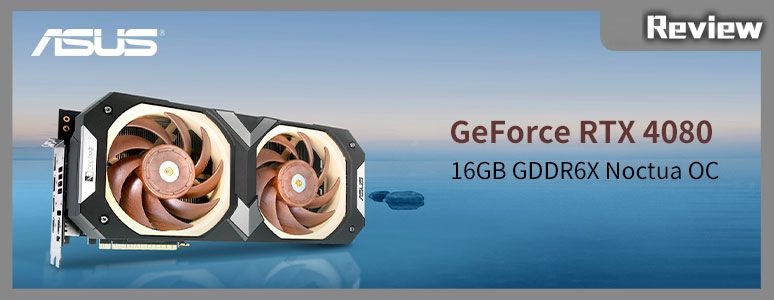
The ASUS GeForce RTX 4080 16GB GDDR6X Noctua OC Graphics Card, a special overclocking edition, boasts features like quiet operation, low heat production, and trustworthiness. This is the third collaborative product from the major brand ASUS X Noctua. It utilizes the NVIDIA Ada Lovelace architecture RTX 4080 graphics card core with a 16GB 256-bit GDDR6X memory specification. The exclusive cooling module, composed of two Noctua NF-A12x25 PWM fans, eight heat pipes, and an expanded vapor chamber, delivers top-tier, whisper-quiet heat dissipation. However, the substantial size and nearly 50,000 yuan price tag pose a significant challenge for both the chassis and fan enthusiasts!
ASUS GeForce RTX 4080 16GB GDDR6X Noctua OC Specifications:
Graphics Core: NVIDIA GeForce RTX 4080
Bus Specifications: PCI Express 4.0 x16
Memory Specifications: 16GB GDDR6X
Memory Clock: 22.4 Gbps
Memory Interface: 256-bit
CUDA: 9728
Tensor Core: 304
RT Core: 76
GPU Clock: Overclocking mode 2625 MHz / Default mode 2595 MHz (Boost)
Display output: 2x HDMI 2.1a, 3x DisplayPort 1.4a
Multi-display output limit: 4
Dimensions: 310 x 144.8 x 87.5 mm
Recommended wattage: 750W
power supply interface: 1x 12VHPWR 16-Pin
Occupied slots: 4.3 Slot
ASUS RTX 4080 16GB GDDR6X Noctua OC graphics card out of the box
This unboxing features a unique graphics card product, the third model resulting from the collaboration between ASUS and the renowned cooling brand, “Noctua Owl”. During the NVIDIA RTX 30 graphics card era, the two companies jointly released two graphics cards: RTX 3080/3070 Noctua OC.
The current ASUS RTX 4080 16GB GDDR6X Noctua OC is built on the NVIDIA Ada Lovelace graphics card architecture. The RTX 4080 GPU core comprises 76 SM units, 9728 CUDA cores, 304 Tensor Cores, and 76 RT Cores. The memory specification for this graphics card is a 16GB 256-bit GDDR6X.
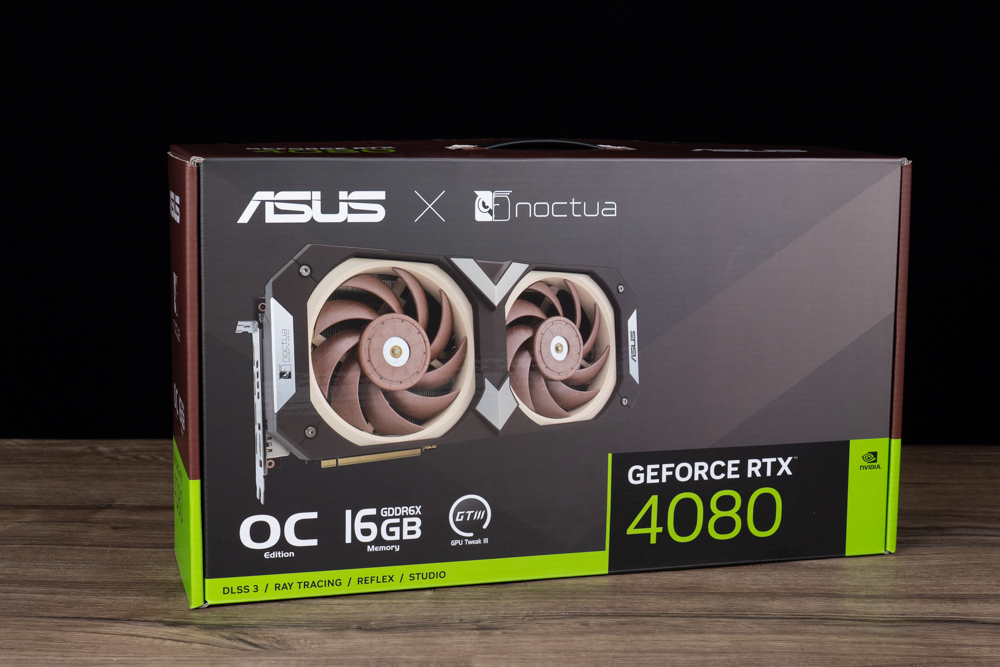

The ASUS and Austrian brand Noctua co-developed RTX 4080 16GB GDDR6X Noctua OC graphics card essentially employs the PCB of the ASUS TUF Gaming GeForce RTX 4080 OC 16GB GDDR6X graphics card. As a result, key specifications such as the graphics card frequency and display output interface match those of the TUF 4080 OC.
The variations between the two models are concentrated on the cooling module. The RTX 4080 16GB Noctua OC, improved upon the ASUS TUF RTX 4080, features two 12cm NF-A12x25 PWM fans replacing the original three 11cm fans. The heat dissipation module is redesigned to enhance heat dissipation performance by expanding the vapor chamber’s area. Moreover, the heat pipe configuration is upgraded from 6x 6mm + 2x 8mm to 3x 6mm + 5x 8mm, increasing the total number of thicker 8mm heat pipes to five.
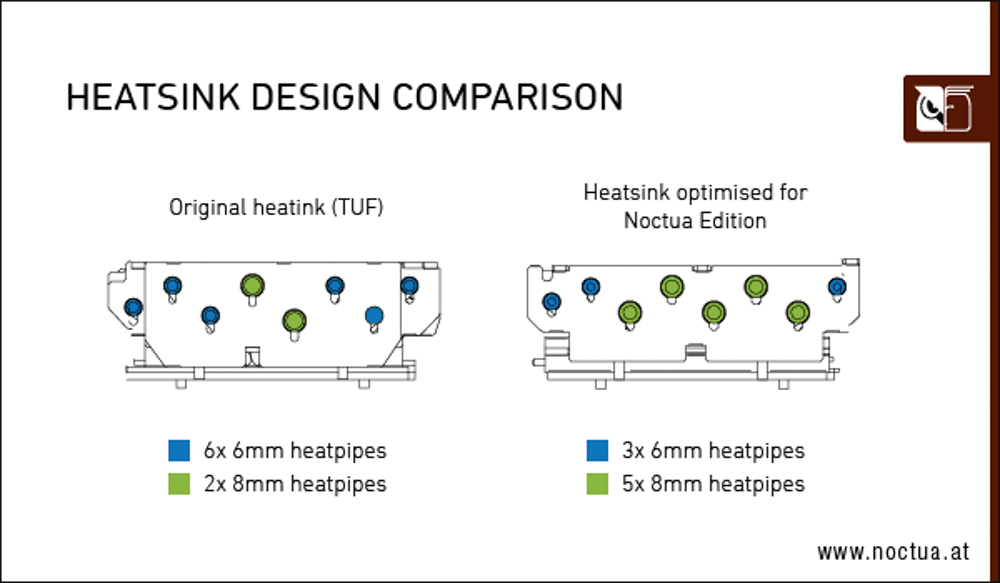
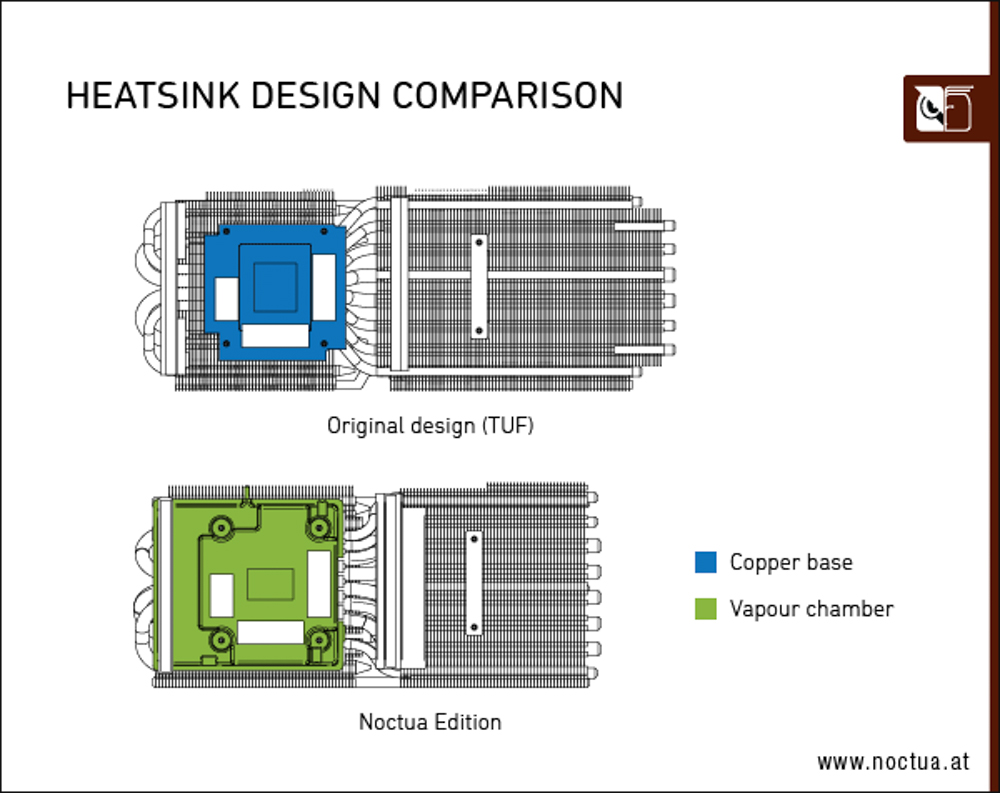
The ASUS RTX 4080 16GB Noctua OC offers features such as intelligent fan stop and dual BIOS version switching. Users can leverage different BIOS to achieve either superior cooling performance or a quieter user experience. Furthermore, even when the graphics card fan runs at its maximum speed of 2000 RPM, the Noctua OC produces only 34.7dB(A) of noise and maintains a temperature of 53.2°C.
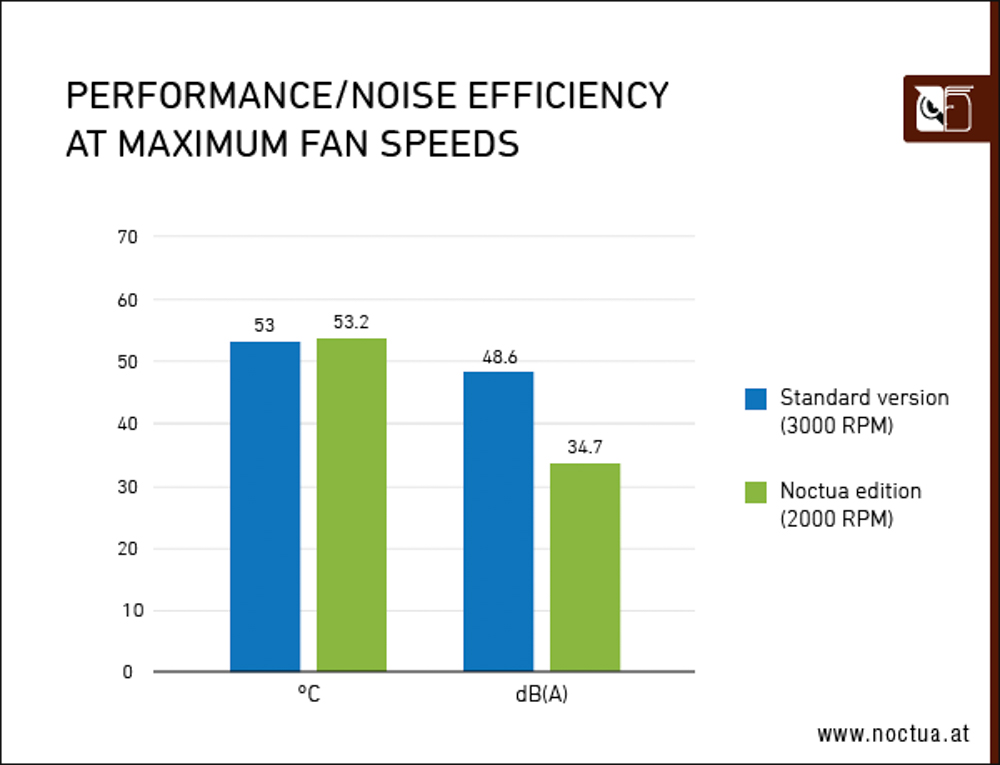
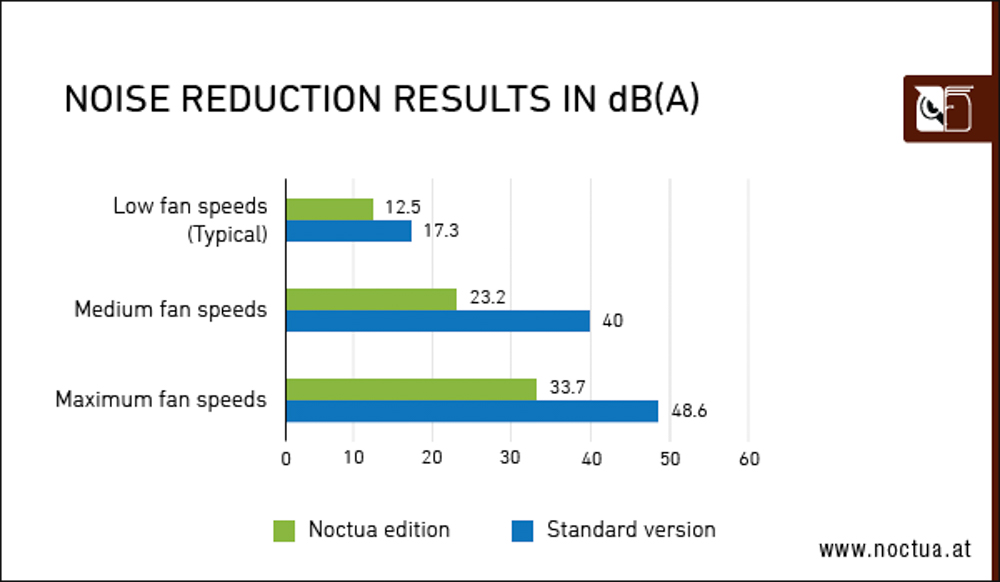
The custom-designed ASUS RTX 4080 16GB Noctua OC is a dual-fan graphics card. However, due to the inclusion of two Noctua NF-A12x25 120mm fans, the card’s size has not decreased but instead increased, with dimensions of 310 x 144.8 x 87.5 mm. Although the length is slightly reduced by 3cm, the thickness of the graphics card has ballooned to a whopping 8.7cm.
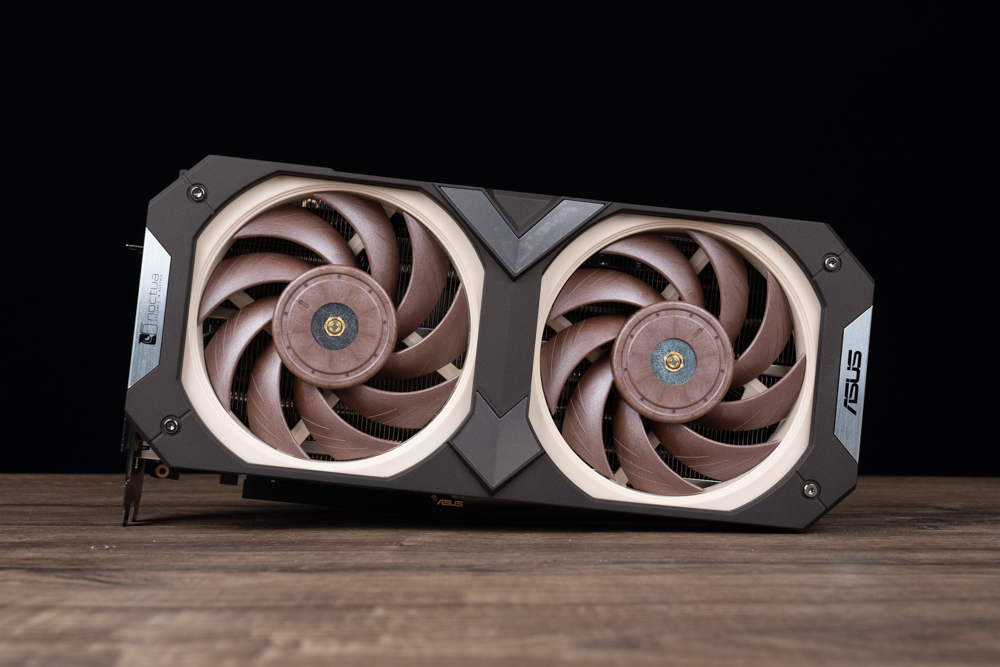
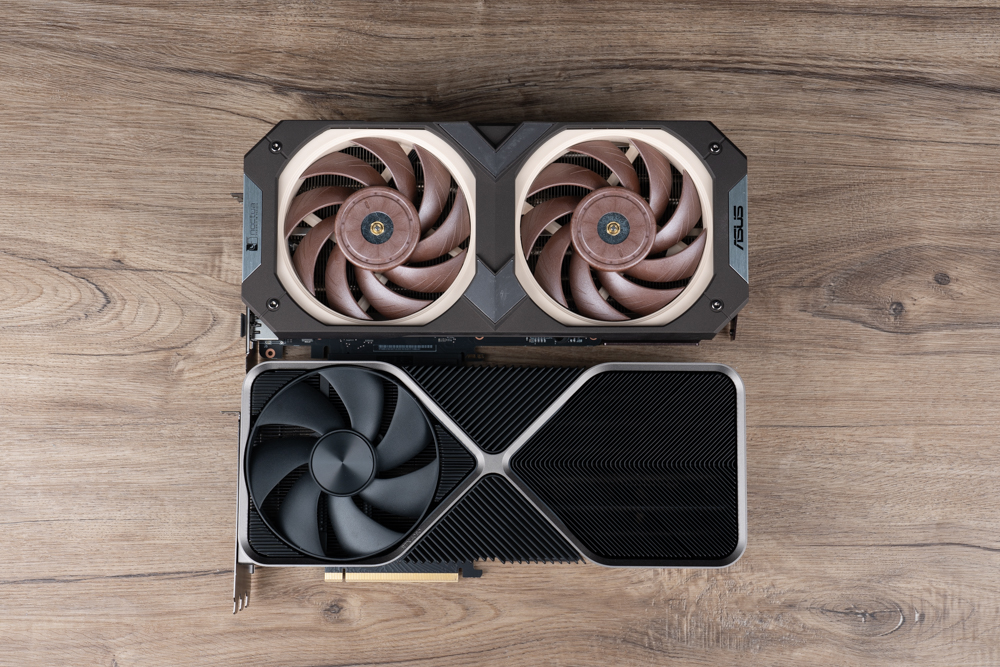
The two Noctua NF-A12x25 PWM fans on the graphics card utilize polymer compound (LCP) fan blades and metal-reinforced motor hubs, delivering robust cooling performance and a quiet user experience. These are the same NF-A12x25 PWM fans that users typically purchase. Thus, if users wish to replace them with NF-A12x25 PWM chromax.black cat fans, they can do so, but at the risk of voiding the warranty.
When the GPU core temperature falls below 50°C, the smart stop function automatically halts the fans, achieving 0dB(A) in a completely silent operating environment. This provides the quietest user experience under standby or light load usage.
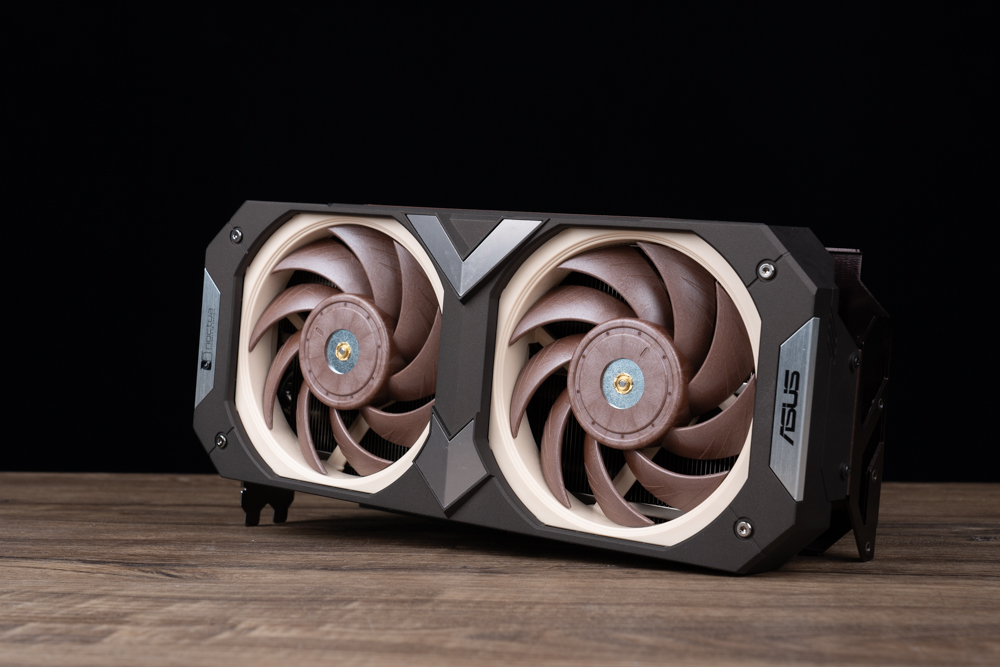
With its thickness of 87.5mm, the graphics card will take up 4.3 Slot PCIe installation space in the chassis. If the graphics card is directly installed with an M-ATX motherboard, only the bottom I/O and other expansion slots will be exposed, rendering the remaining PCIe Slot expansion slots virtually unusable. On the other hand, an ATX host can just manage to utilize the bottom PCIe Slot expansion slot.
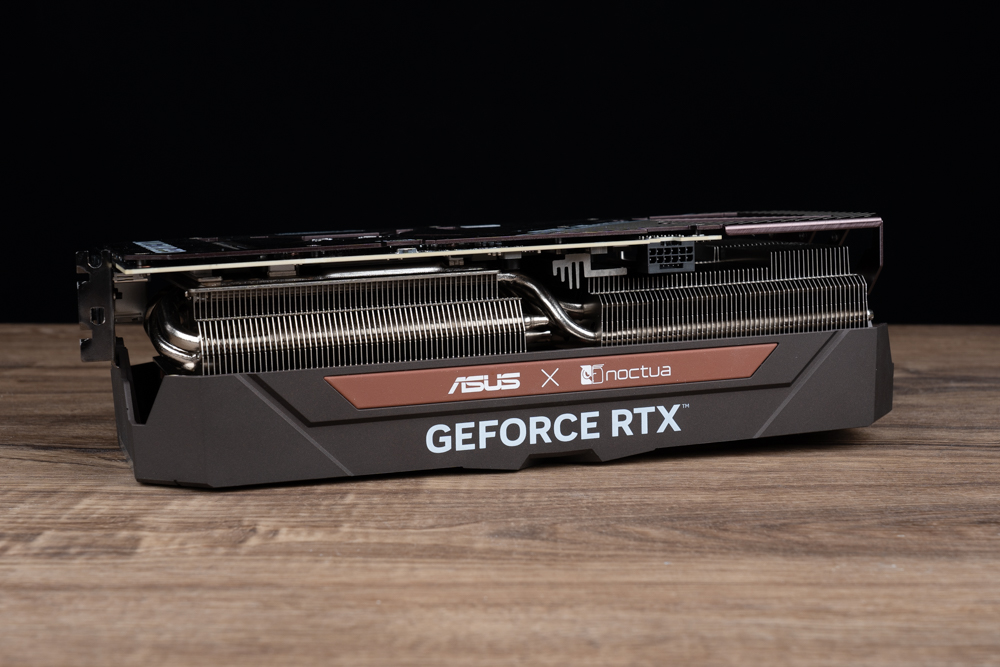
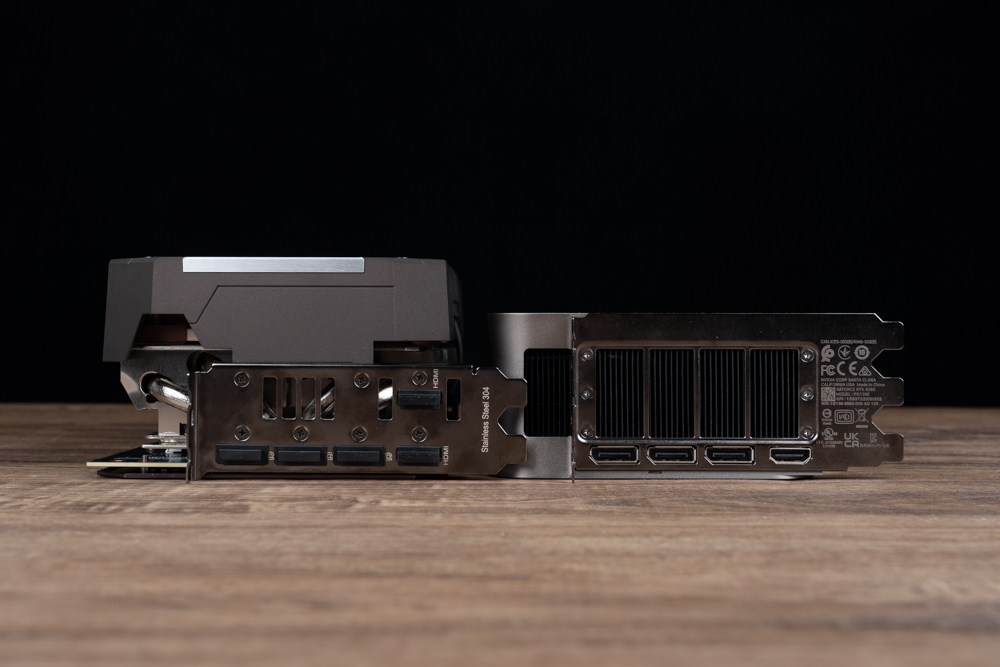
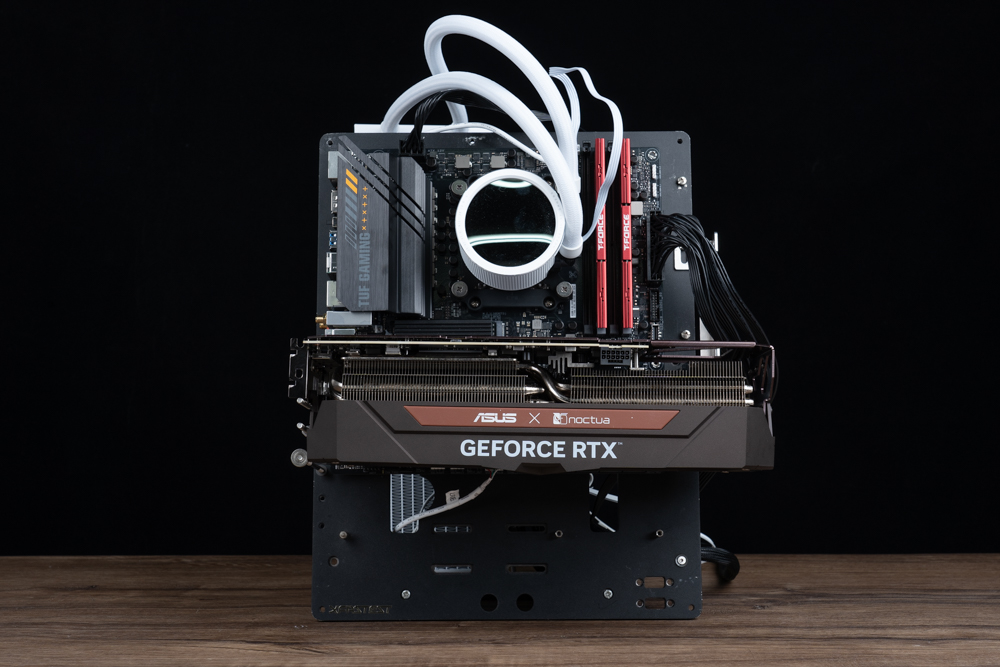
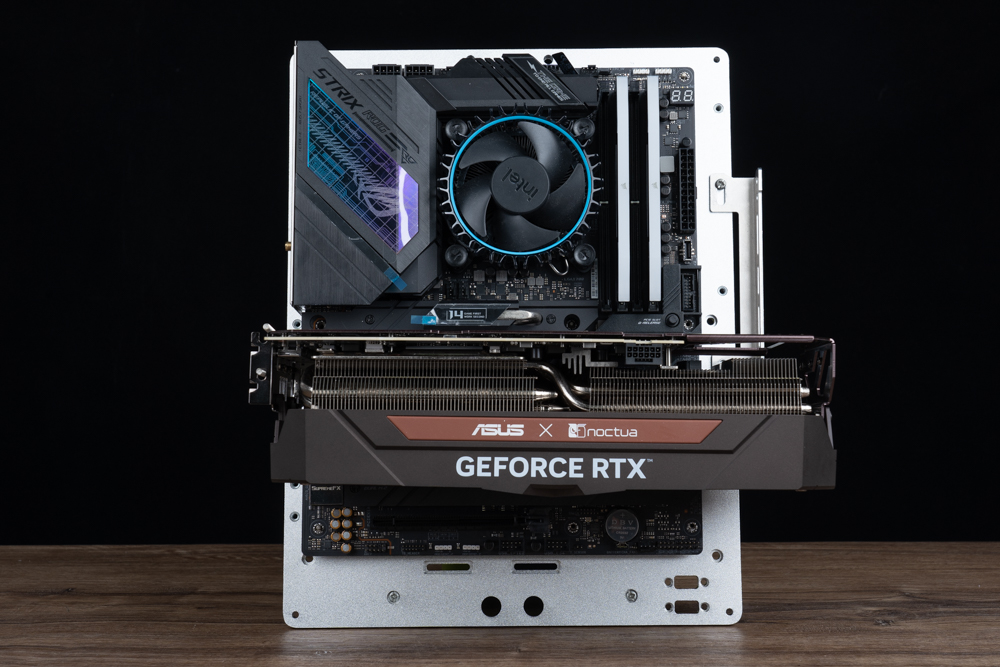
The power supply interface employs a 12VHPWR 16-Pin slot. If users haven’t yet acquired a power supply that natively supports 12VHPWR cables, they can use the provided 3x PCIe 8-Pin to 12VHPWR 16-Pin adapter to connect to the power supply.
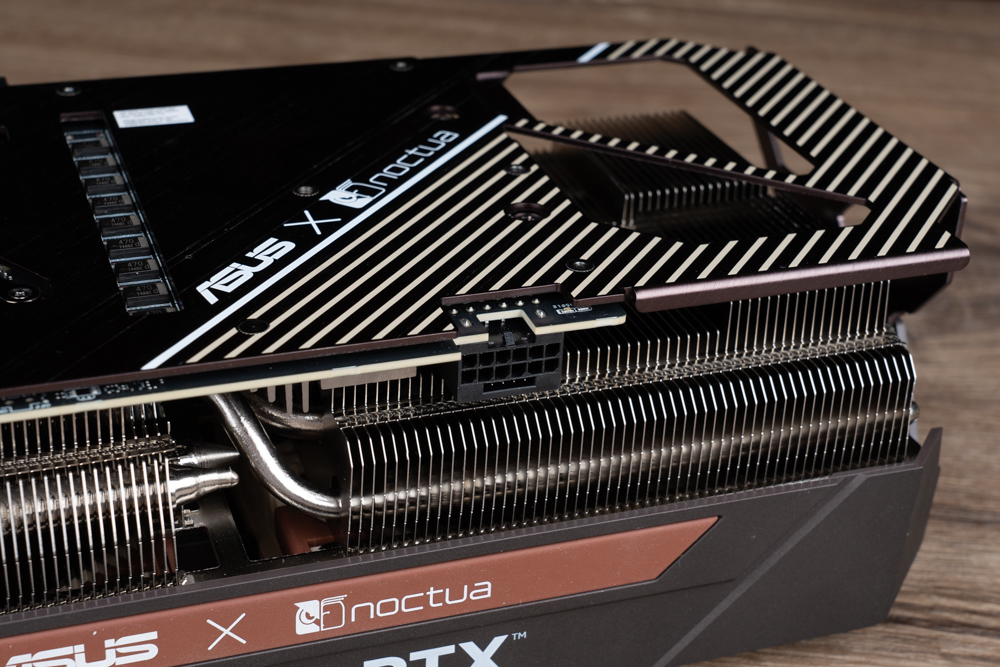
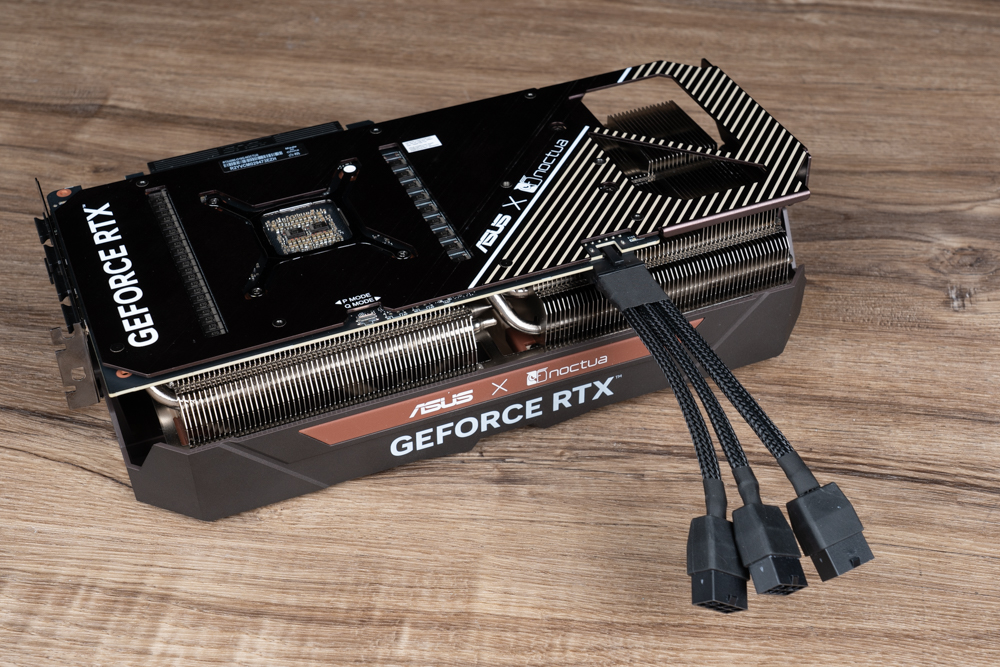
The graphics card employs a metal backplane on the rear to bolster the physical durability of the PCB itself. Given the significant weight of the Noctua OC graphics card, this reinforcement is not to be taken lightly. Large vents at the end of the backplane allow cooling air to flow through the fins and heat pipes and then directly through the heat dissipation modules for enhanced cooling efficiency.
There’s a dual BIOS switch on the reinforced back panel, preset to Performance Mode. To the right, users can switch to Quiet Mode, which operates at a lower fan speed. The graphics card was tested using the Performance Mode.
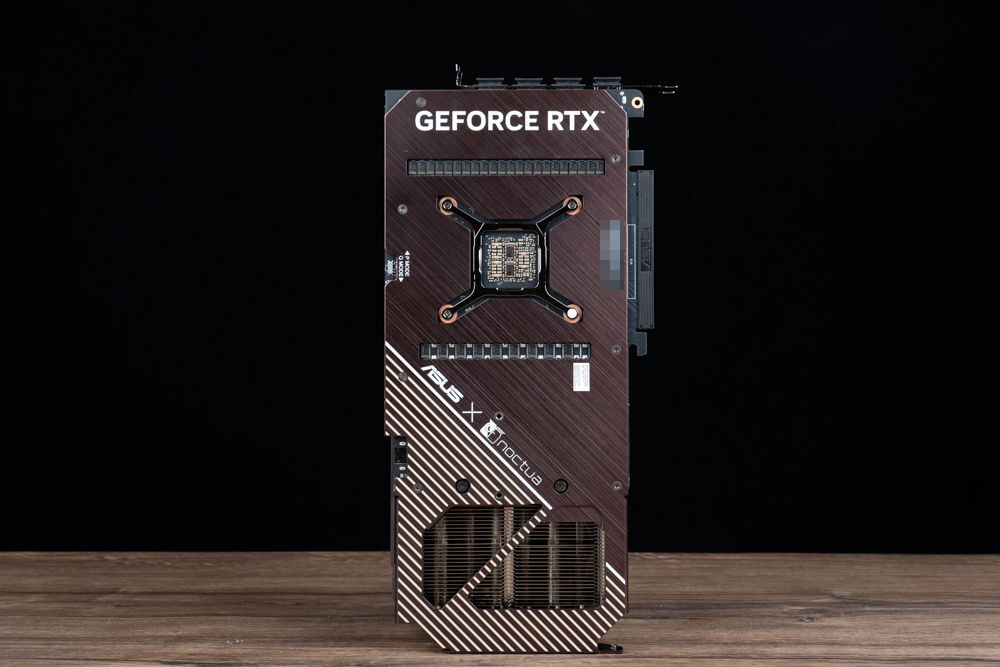
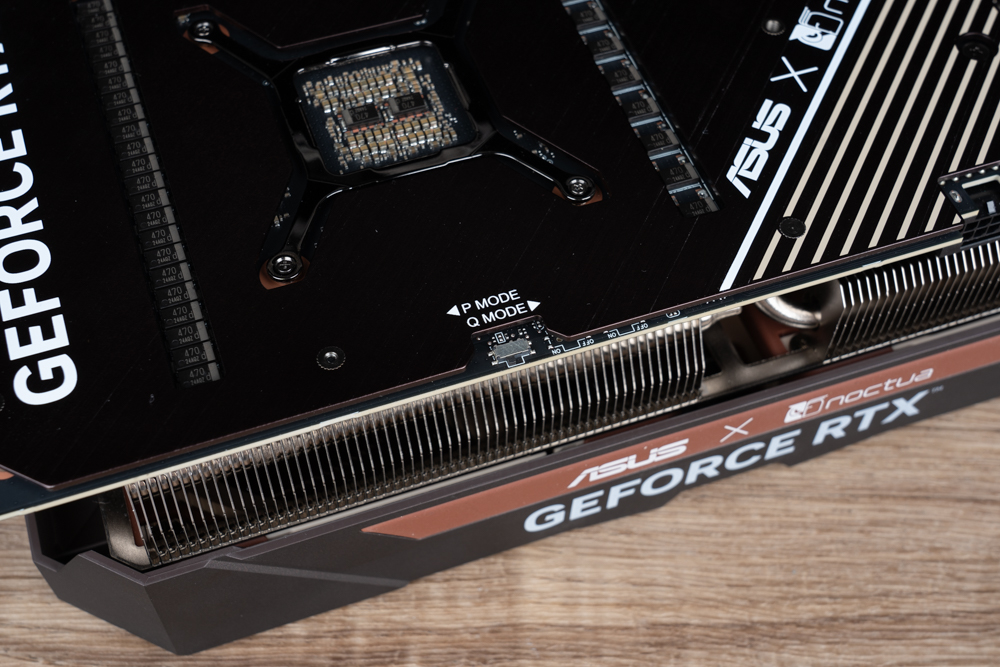
The display output interface offers three DisplayPort 1.4a and two HDMI 2.1a ports, supporting simultaneous output to up to four screens and 8K resolution (7680 x 4320) imagery. The gold-plated fingers and dust-proof protective cover of the screen interface are factory-installed to prevent scratches or oxidation during use.
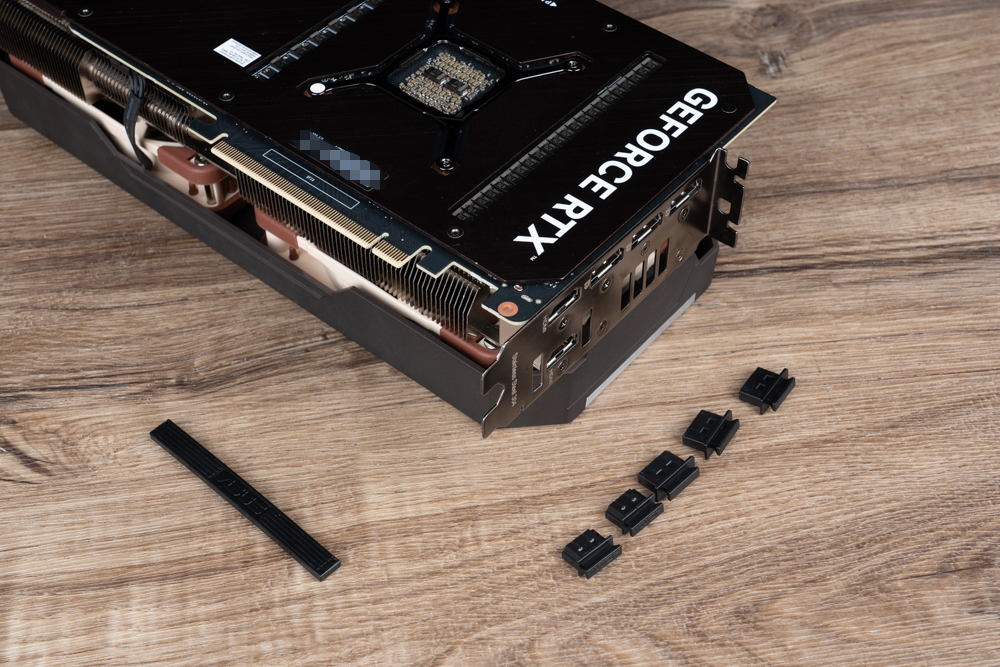
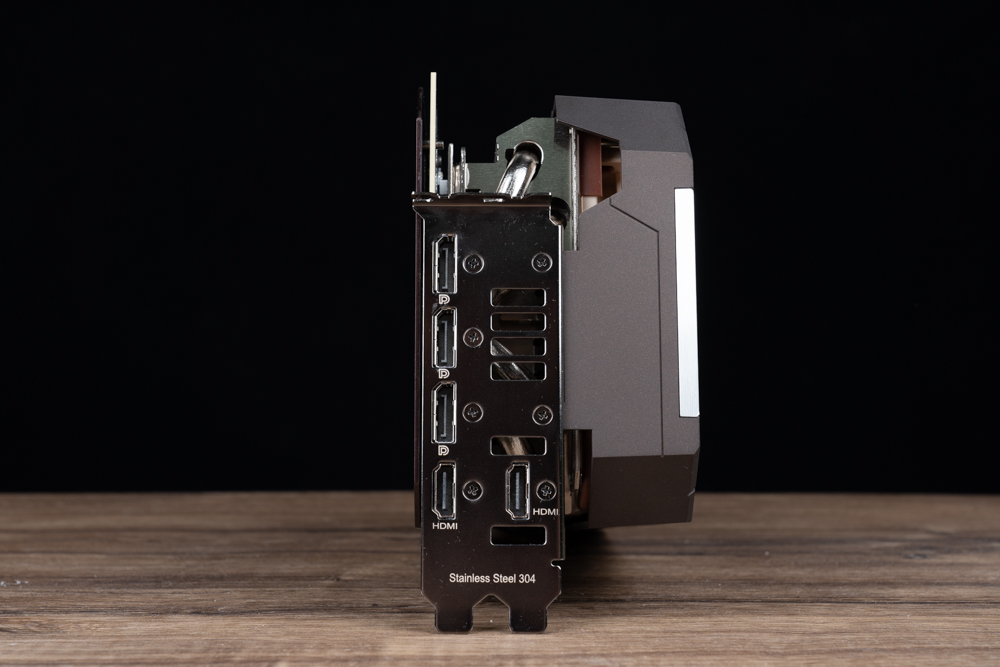
Upon disassembling the graphics card for everyone to see the internals, it’s clear that it truly is a product crafted in partnership with Noctua. The cooling module is so hefty that it could be mistaken for a weapon. One can’t help but fear that it would cause significant injury if it were to strike someone on the head! A nickel-plated vapor chamber and a total of eight heat pipes are utilized to manage the heat from the NVIDIA AD103-301-A1 core and eight Micron graphics card memory chips.
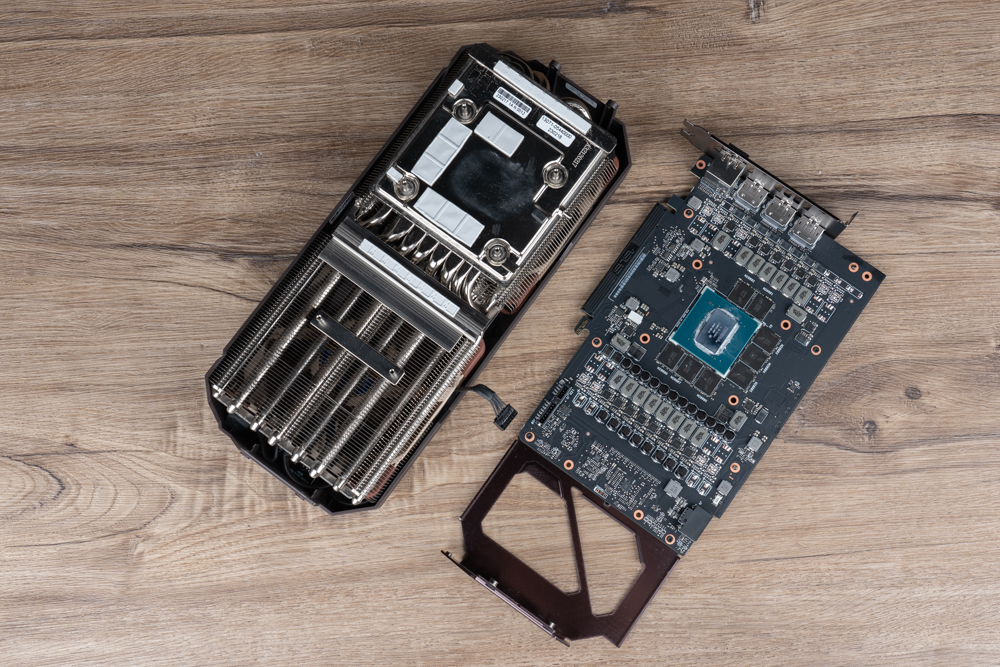
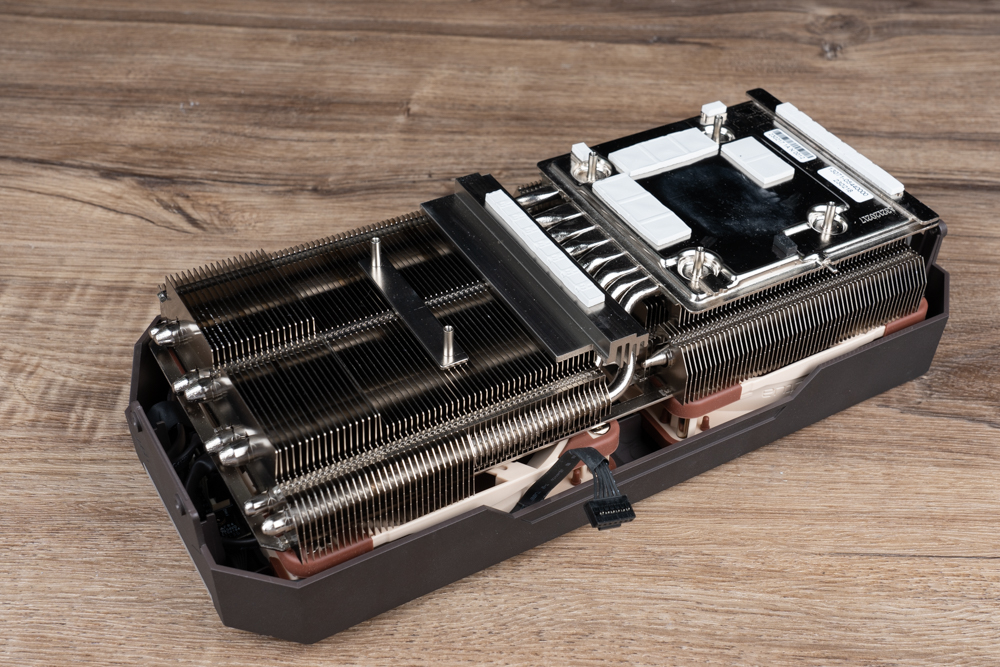
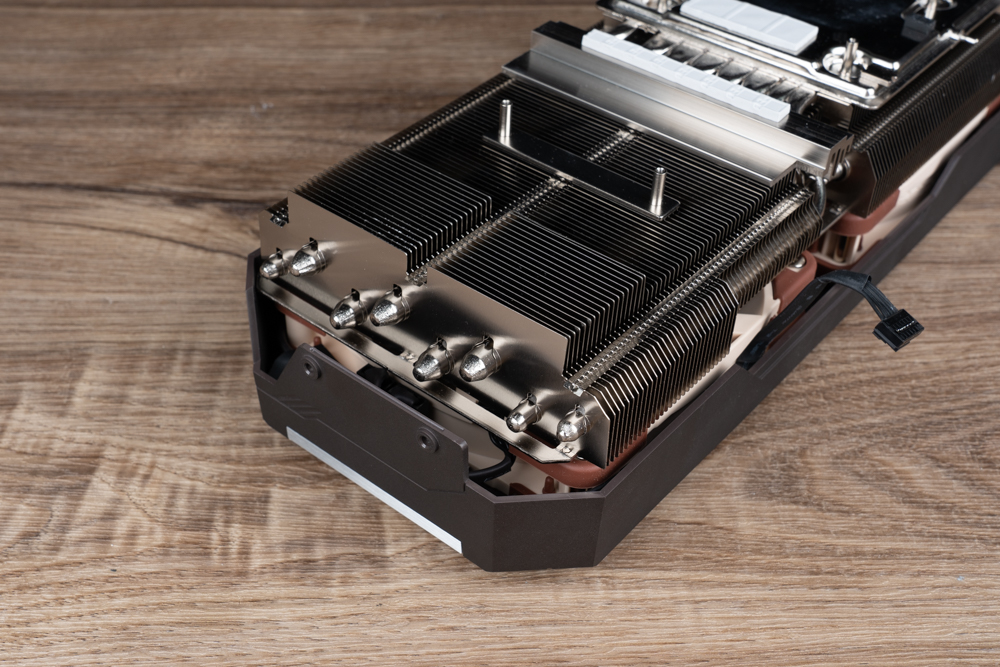
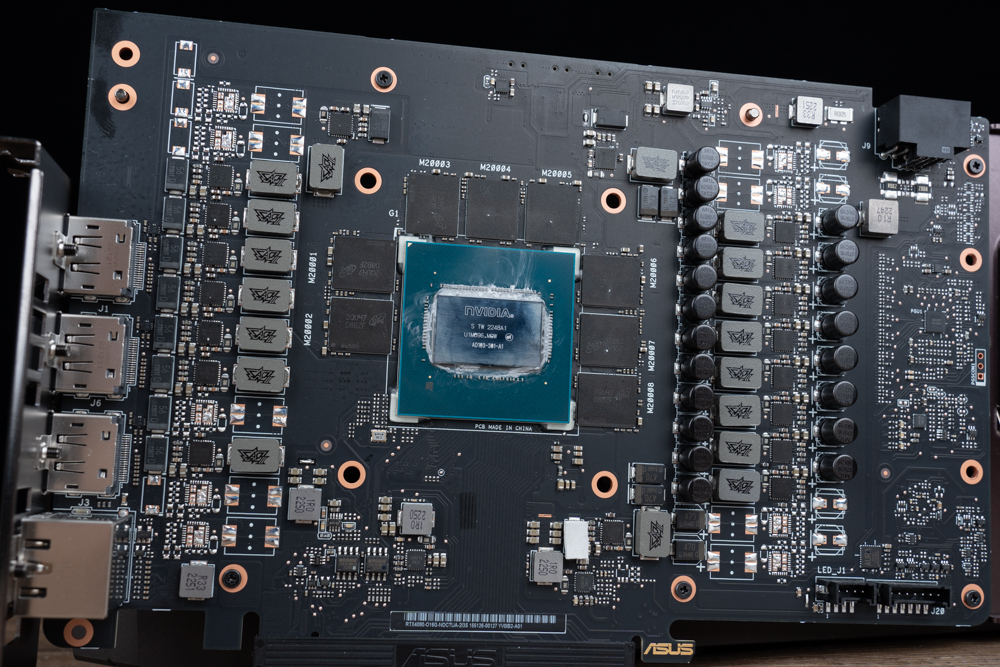
The contents of the graphics card box, which could be referred to as faith accessories, include a 3x PCIe 8-Pin to 12VHPWR 16-Pin power supply cable, a graphics card support frame with a screwdriver, and a Noctua collector’s card.
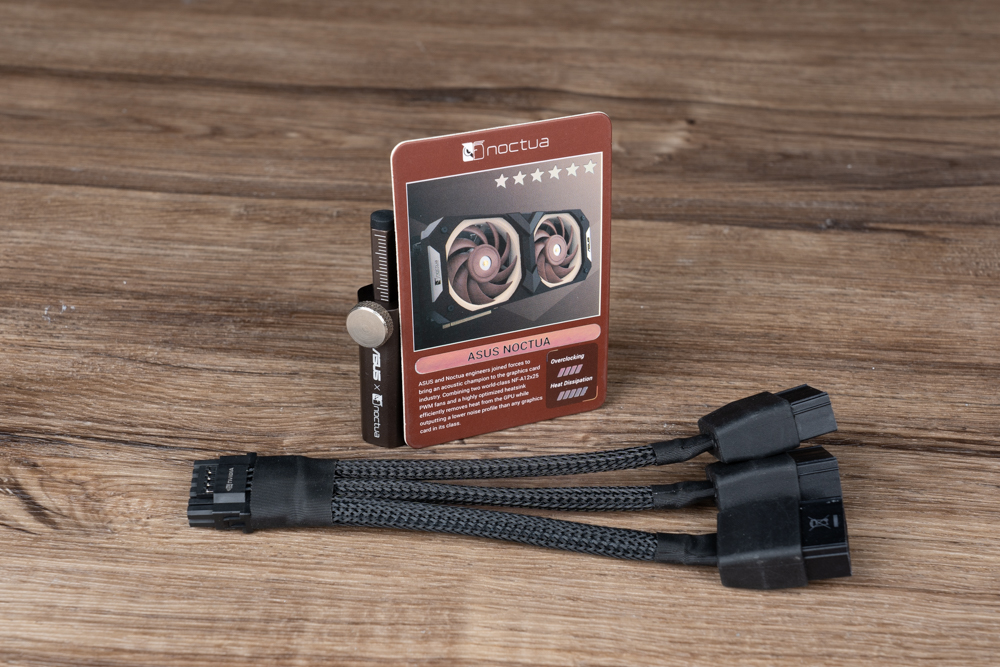
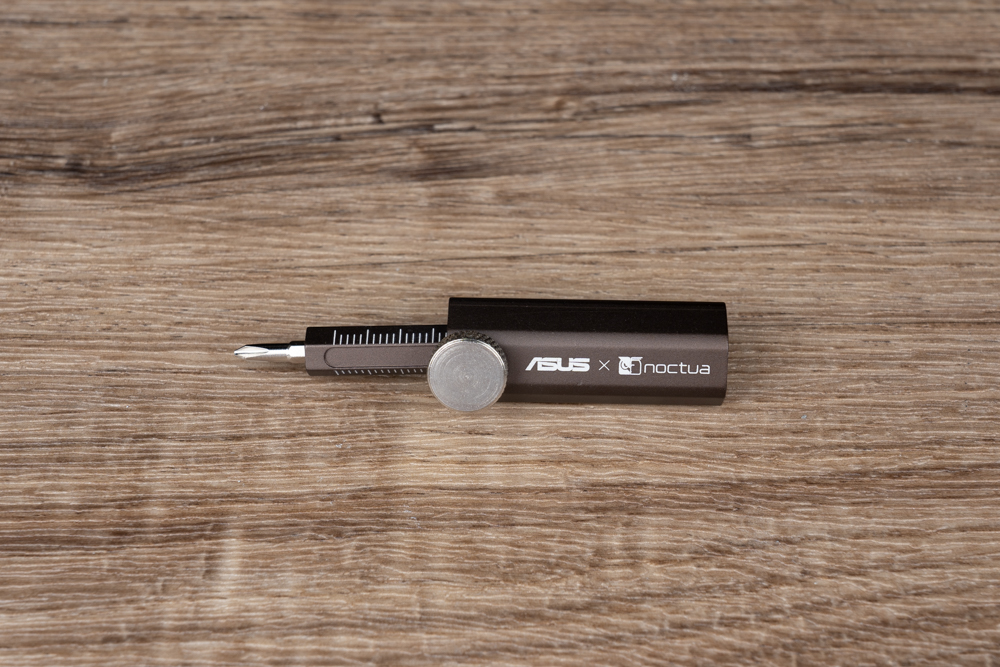
GPU Tweak III Graphics Card Three Modes Easily Switch
ASUS’ proprietary GPU Tweak III software incorporates graphics card information monitoring and overclocking capabilities. The software offers three quick-switch modes: preset, overclocking, and mute. Naturally, users can also directly adjust the parameters for overclocking within the software. The software includes a graphics card monitoring function and the ROG version of GPU-Z for specification viewing.

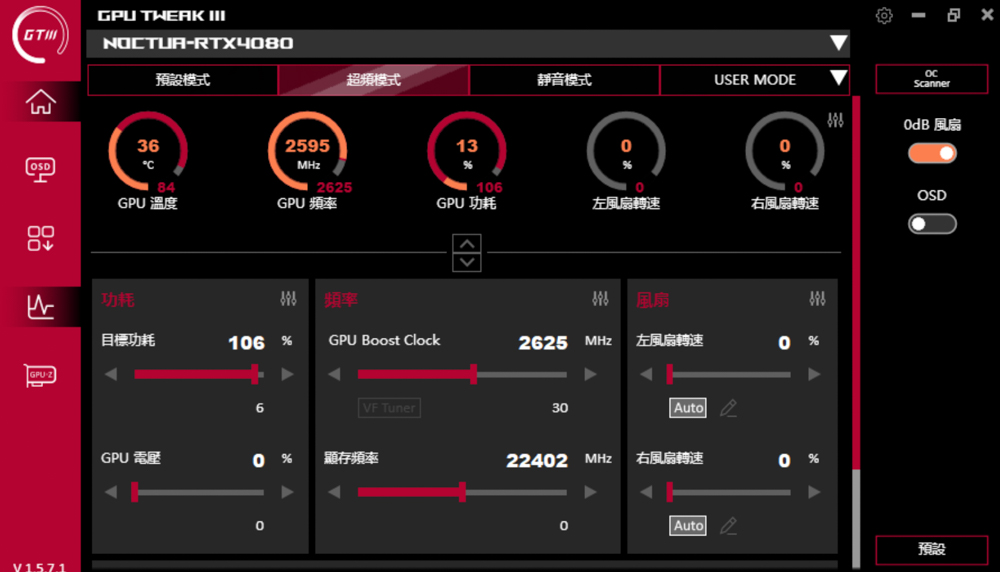
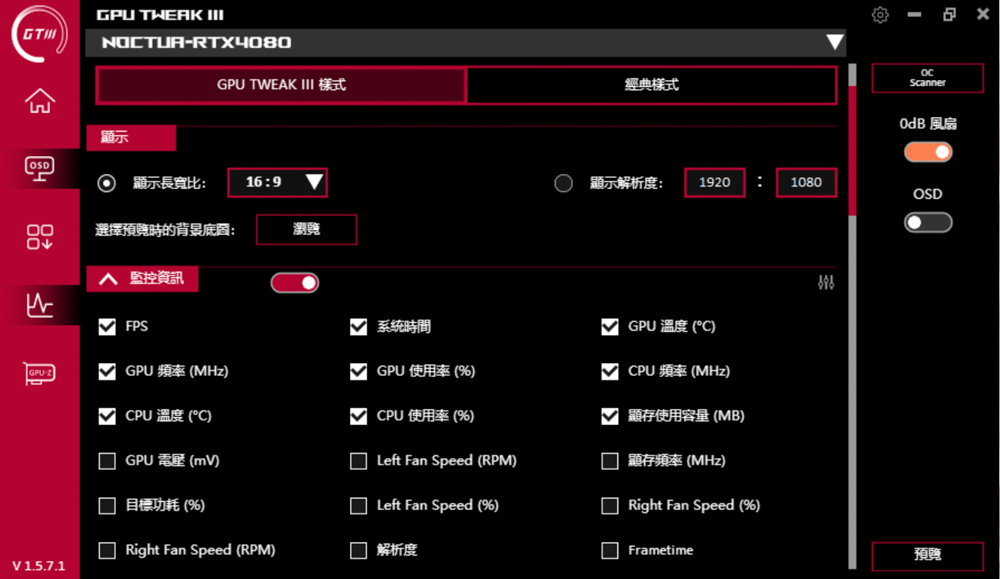
Display card professional creation and rendering test
Eight different professional software applications were employed for the testing process, including OctaneBench 2020.1.5, Indigo Bench, Blender Benchmark, SPECviewperf 2020 v3.1, Superposition 2017, UL Procyon benchmark, Vray5, and Geekbench 6. These represent a range of different domains, with many encompassing rendering, video clip conversion, and other tests, offering insights via the built-in benchmark tests of various professional software.
The test platform utilized an AMD Ryzen 9 7900 processor and ROG RYUO III 360 ARGB integrated water cooling, coupled with an ASUS TUF GAMING A620M-PLUS WIFI motherboard and T-Force VULCANα DDR5 5600 MT/s 8GBx2 dual-channel memory. The focus of the testing was the ASUS GeForce RTX 4080 16GB GDDR6X Noctua OC graphics card.
Prior to testing, the motherboard BIOS was updated to the latest version 0407, with EXPO, Resizable Bar, and processor PBO enhancements enabled in the BIOS. To better align with professional multimedia usage scenarios, the NVIDIA Studio driver version 531.16 was used in the professional software test for the graphics card. For game nature testing, GeForce Game Ready 531.79 was downloaded and run.
Test platform
Processor: AMD Ryzen 9 7900
Radiator: ROG RYUO III 360 ARGB
Motherboard: ASUS TUF GAMING A620M-PLUS WIFI (0407)
Memory: T-Force VULCANα DDR5 5600 MT/s 8GBx2
Display card: ASUS GeForce RTX 4080 16GB GDDR6X Noctua OC
Operating System: Windows 11 Professional Edition 21H2
System Disk: Corsair MP600 PRO LPX 1TB PCIe Gen4 x4 NVMe M.2 SSD
Game Disk: GIGABYTE AORUS NVMe Gen4 SSD 2TB
Power Supply: FSP Hydro G PRO ATX3.0 (PCIe5 .0) 850W
graphics card driver: NVIDIA Studio 531.16/GeForce Game Ready 531.79
Using GPU-Z to view the specification details of the RTX 4080 graphics card reveals that the 4nm process AD103 core comprises 9728 CUDA cores. The graphics card’s memory specification is 16384MB GDDR6X 256bit, and the default clock frequency of the GPU is set to 2235 Mhz / Boost 2625 Mhz.
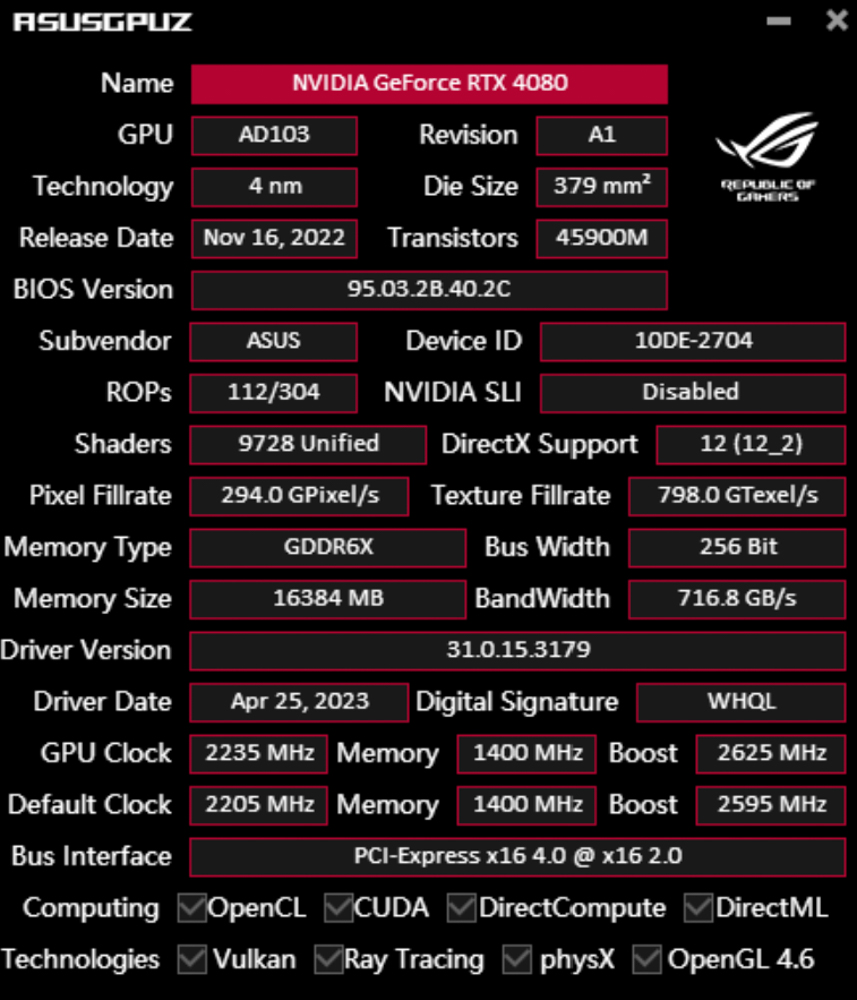
OctaneBench 2020.1.5 is a benchmark test that stems from the OctaneRender GPU rendering engine. Users can leverage the free OctaneBench to compare the rendering performance of various graphics cards. OctaneRender incorporated ray tracing effects starting from version 2020.1.1, allowing NVIDIA RTX series graphics cards to enable RTX acceleration in OctaneBench 2020.1. When considering the performance enhancement offered by RTX series graphics cards in ray tracing rendering tasks, this graphics card scored 964.93 points in this test.
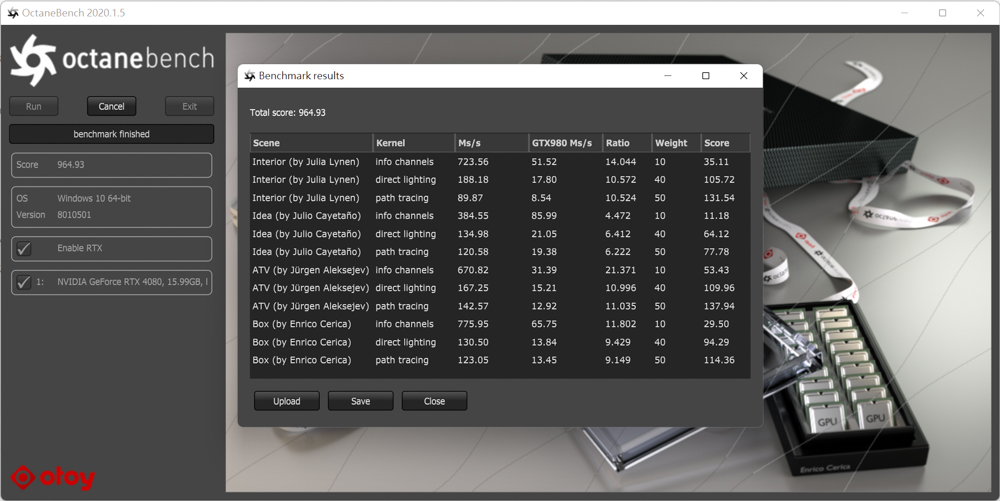
Indigo Bench is a free testing software that utilizes the Indigo 4 rendering engine. It employs the OpenCL architecture and supports NVIDIA, AMD, and Intel graphics cards and processors for rendering performance testing. The test provides two rendering samples: a bedroom and a sports car. The unit of rendering per second is given in grades, with a higher grade indicating superior performance. In this case, the grades were 25.558/64.169 (M samples/s).
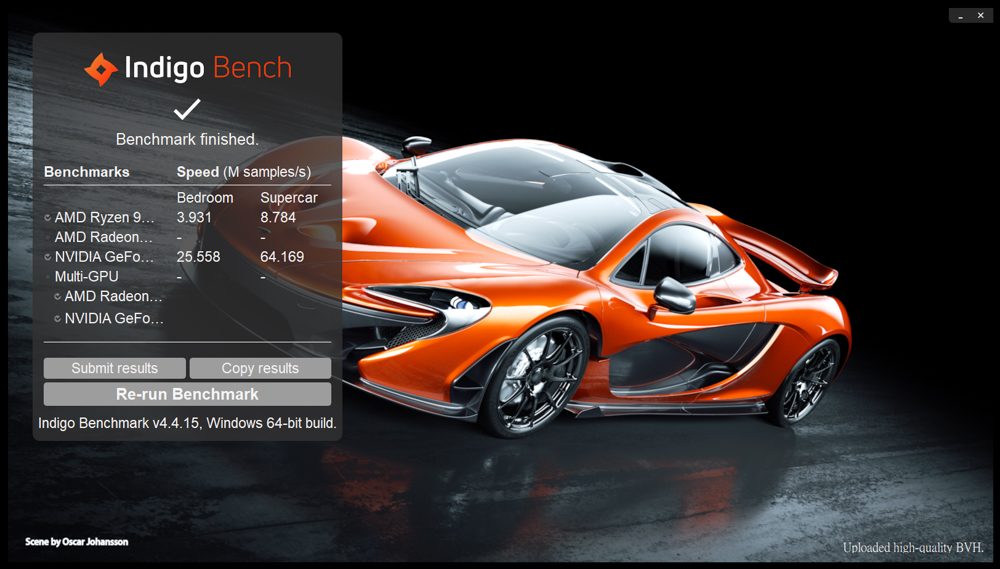
Blender Benchmark Launcher 3.5.0 is a free benchmarking software provided by the 3D graphics software Blender. Users can opt to conduct tests on the CPU or GPU during the benchmark. The testing process involves running three scenarios: monster, junkshop, and classroom.
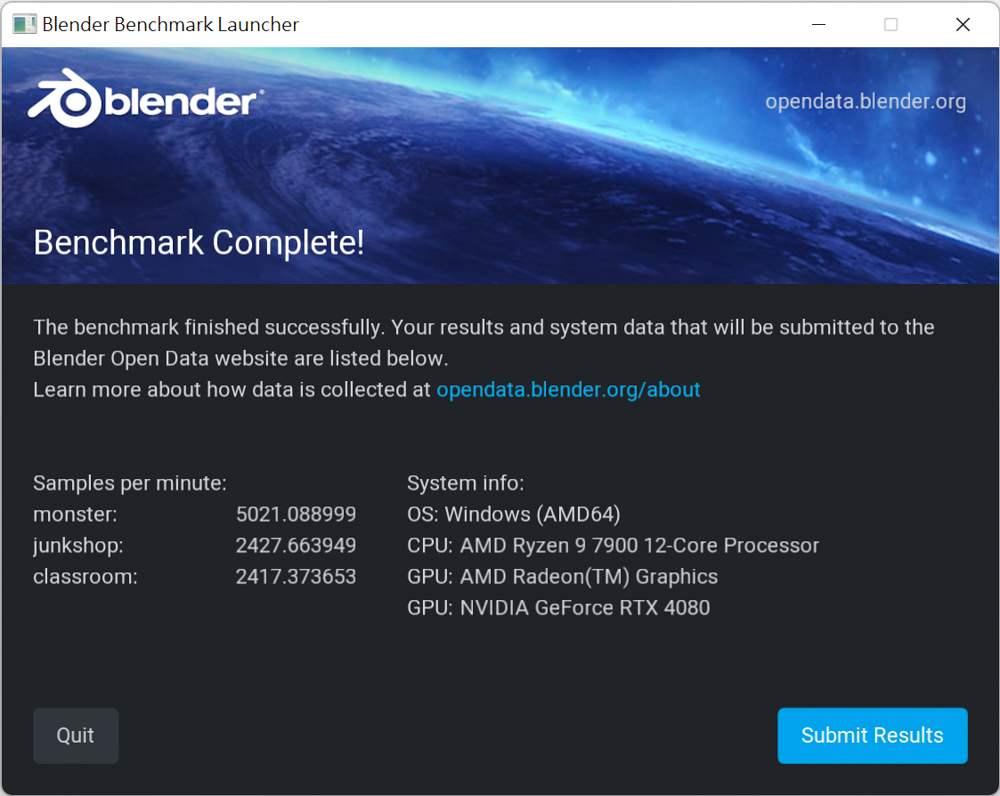
SPECviewperf 2020 v3.1 incorporates 3D graphics and rendering software across a range of professional work fields. The testing software employs OpenGL and DirectX APIs to conduct 3D graphics performance simulation tests. This time, the test items at 3840×2160 4K quality include 3ds Max, CATIA, Creo, Energy, Maya, medical, snx, and SolidWorks, among others.
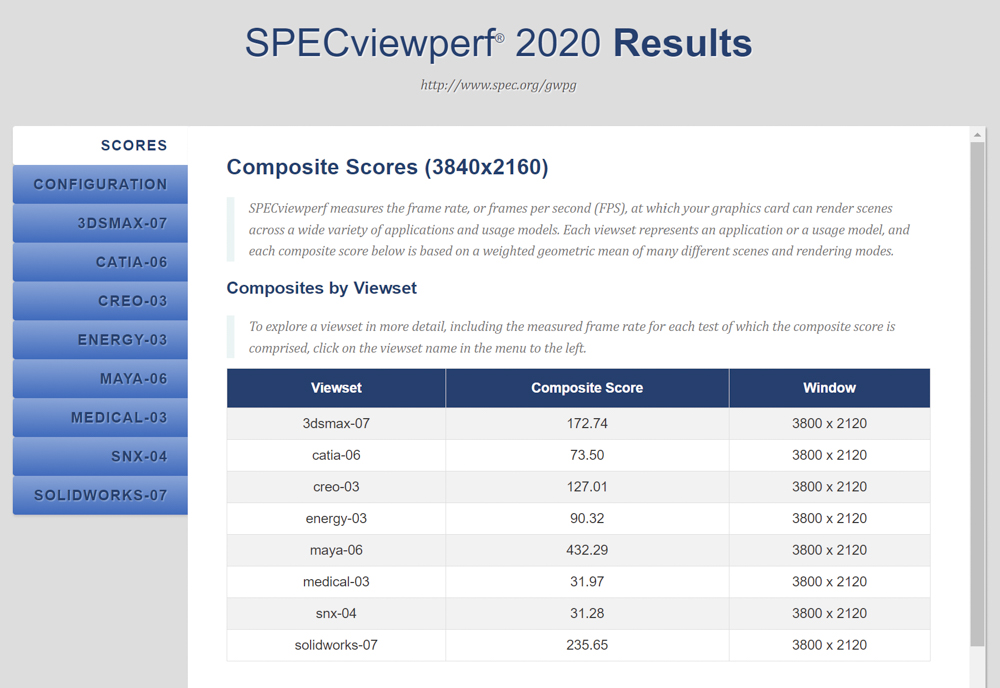
Superposition 2017 is a benchmarking software based on the UNIGINE 2 engine. The UNIGINE engine is frequently used in the development of simulators, cross-platform games, VR, and 3D construction software. It supports graphics APIs such as OpenGL 4, Vulkan, and DirectX 12. In the graphics test on the Benchmark, the API option employed is DirectX, and the measurements are taken at 8K quality. This resulted in a score of 8429 points and an average FPS of 63.05 in the 8K project.
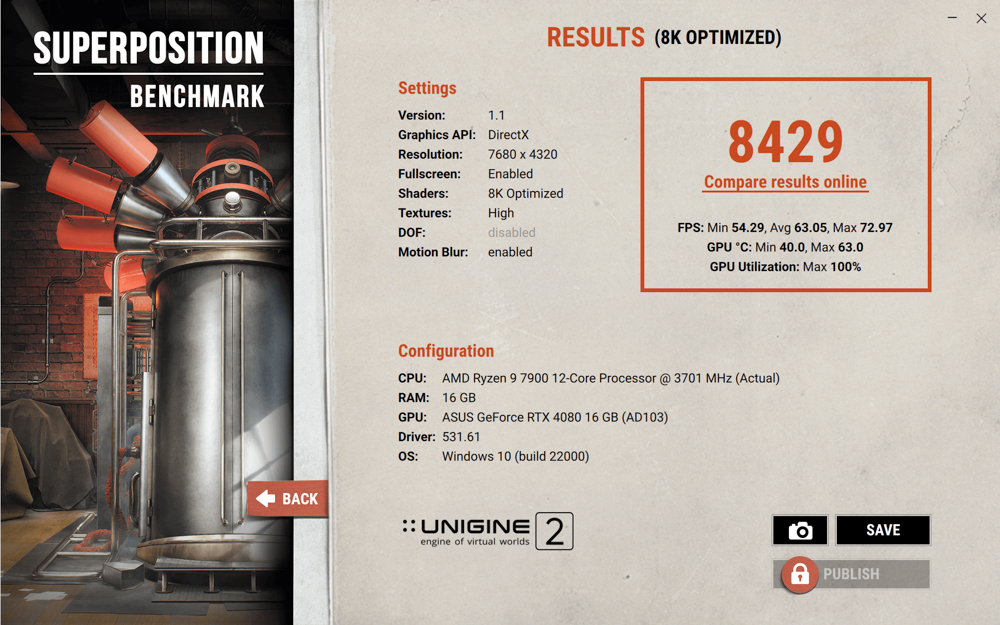
UL Procyon uses two benchmarks for testing: the Video Editing Benchmark and the Photo Editing Benchmark, both of which utilize Adobe software for benchmarking.
The Video Editing Benchmark employs Adobe Premiere Pro for testing. For media editing professionals, Adobe Pro has never had a unified test reference. During this benchmark test, two video files are first imported, edited, and adjusted. After applying special effects, an H.264 (Youtube 1080P) / H.265 (4K) output test is conducted to obtain the total score.
The Photo Editing Benchmark begins with importing a digital negative (Digital Negative) into Adobe Lightroom Classic for the first test. The DNG image is then cropped, stretched, and modified. The second test employs Adobe Photoshop to edit the effect with multiple layers and then export it to acquire the image retouching score/batch processing score.
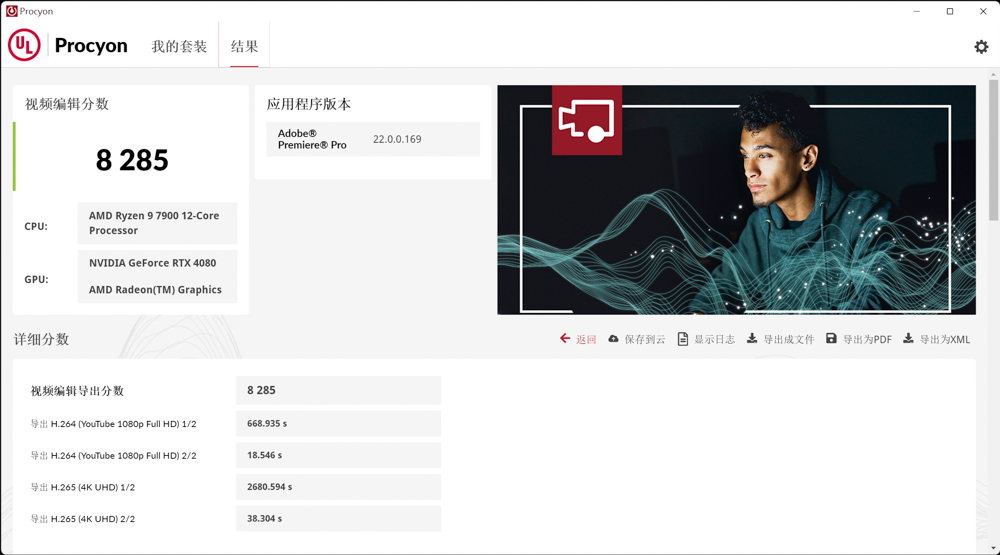
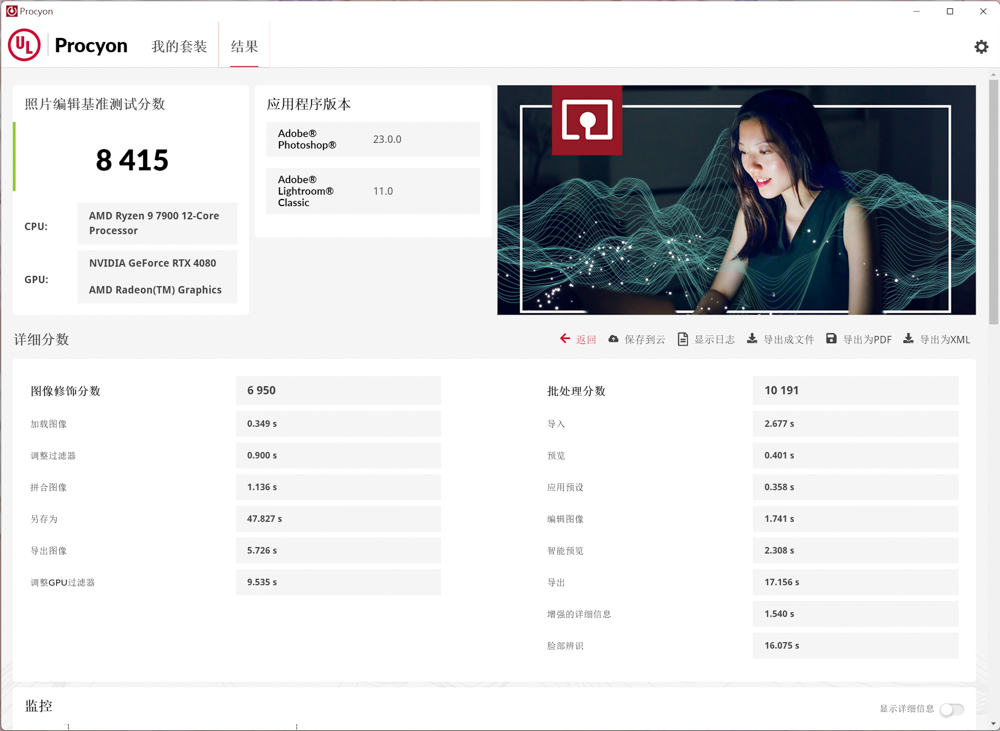
V-Ray 5 is a testing software for the image rendering program V-Ray, developed by Chaos Group. It employs a free Benchmark to evaluate the rendering speed of both CPU and GPU on the V-Ray engine. The V-Ray GPU CUDA projects can blend CPU and GPU rendering concurrently, and testing can also be performed separately. The V-Ray GPU RTX project is compatible with NVIDIA RTX series graphics cards for ray tracing rendering tests.
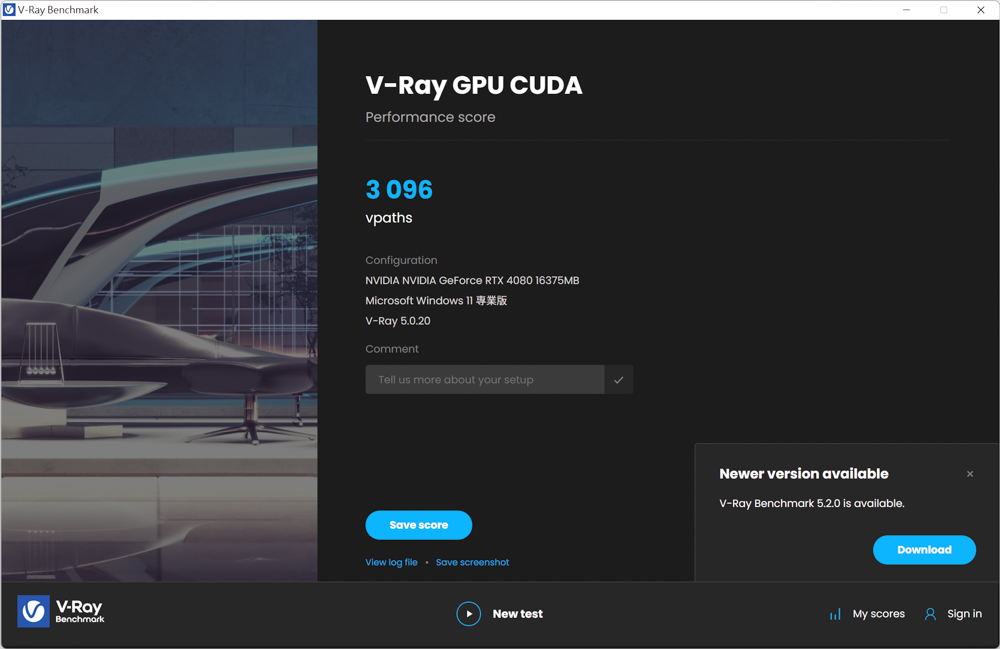
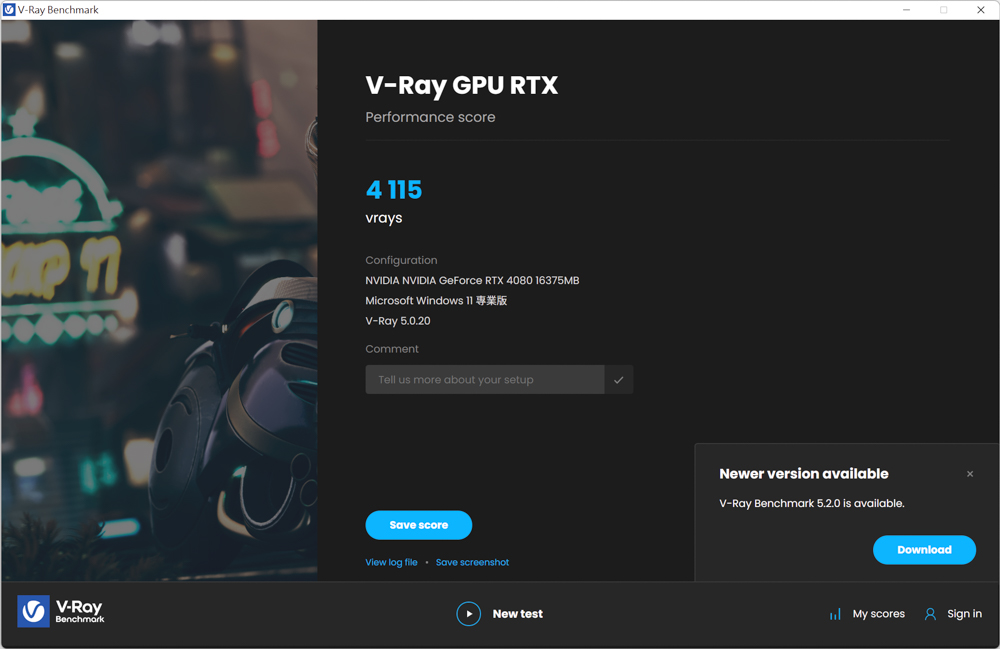
Geekbench 6 includes inbuilt CPU and GPU benchmark tests. The GPU Compute Benchmark project within Geekbench 6 can be used to assess the professional performance of graphics cards, which includes tasks such as image processing, rendering, and machine learning (ML). The test incorporates a multitude of tasks, including deep learning workloads, background blur, face detection, image editing, level detection, edge detection, Gaussian blur, image synthesis, feature matching, stereo matching, physics samples, among others, to compute the final score. The GPU API can be chosen between OpenCL or Vulkan for the testing.
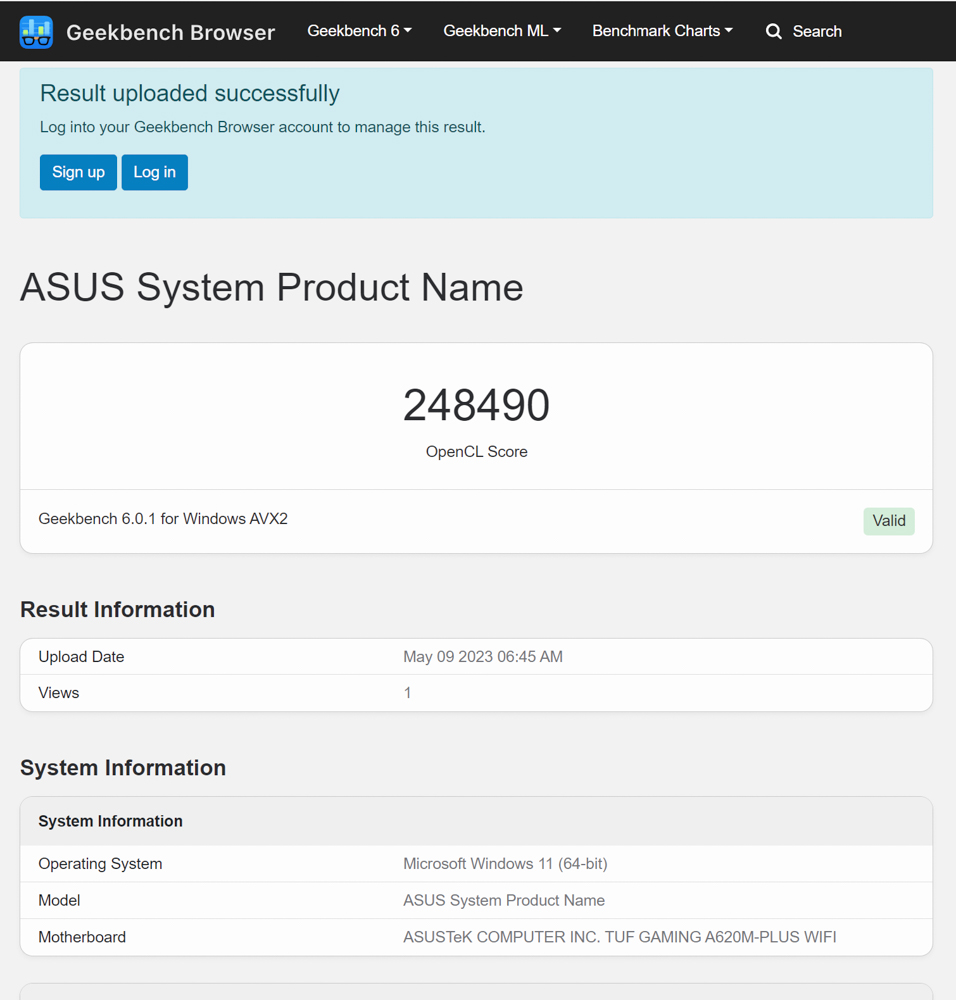
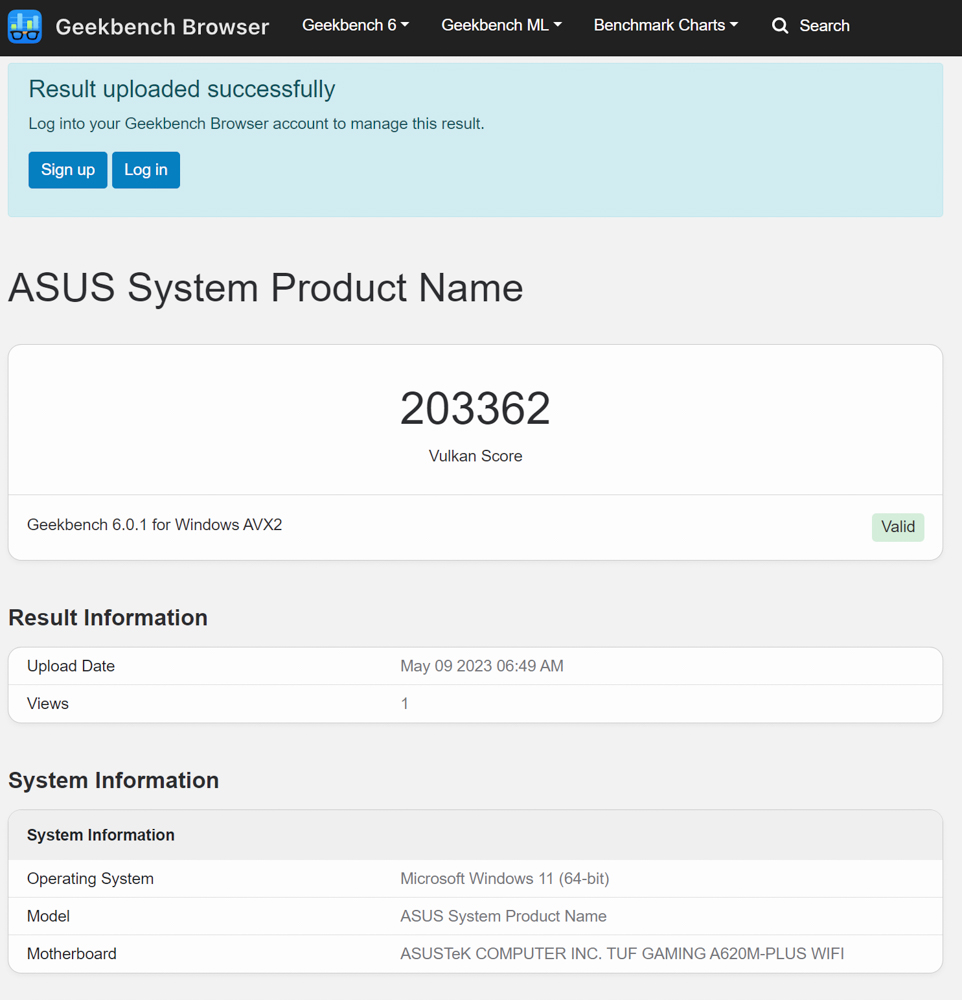
3DMark running score test
To assess the graphics cards in various aspects and image qualities, the 3DMark software, which currently provides comprehensive gaming performance scores, will be utilized. The tests will employ the GeForce Game Ready 531.79 driver. Additionally, EXPO and Resizable Bar will be enabled, and the overclocking mode in GPU Tweak III will be activated to allow the ASUS RTX 4080 Noctua OC to run at higher frequencies.
For the 3DMark Fire Strike test, which employs the DirectX 11 GPU API, two tests are conducted: one for physics and another for CPU and GPU performance. These tests evaluate gaming performance under three image qualities: 1080p, Extreme 1440p, and Ultra 2160p. The results are as follows:
- Fire Strike (1080p): Total Score/Graphics Score – 45753/62436
- Fire Strike Extreme (1440p): Total Score/Graphics Score – 30416/32686
- Fire Strike Ultra (2160p): Total Score/Graphics Score – 17213/16988
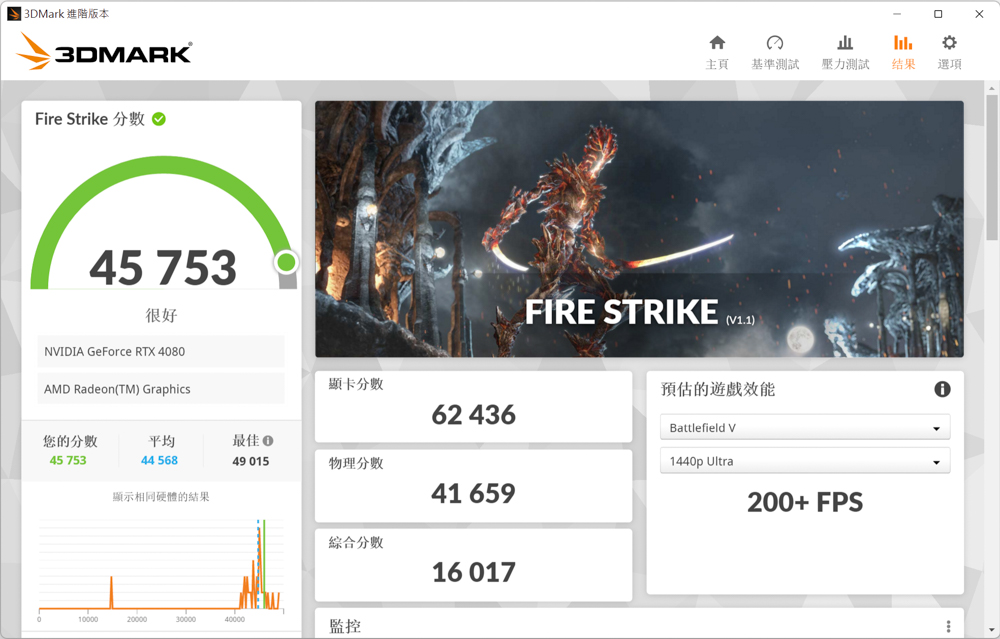
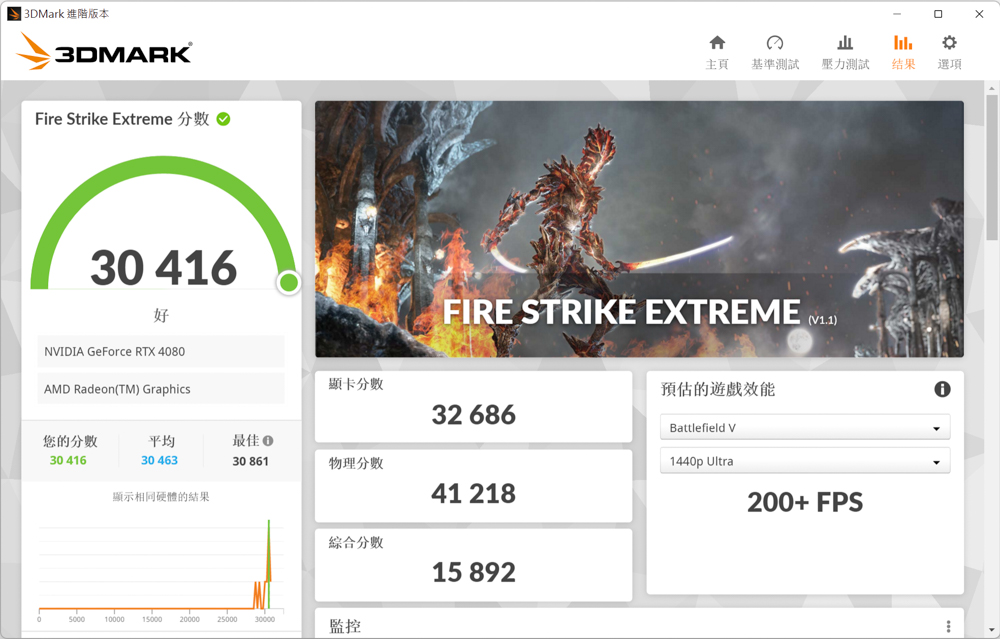
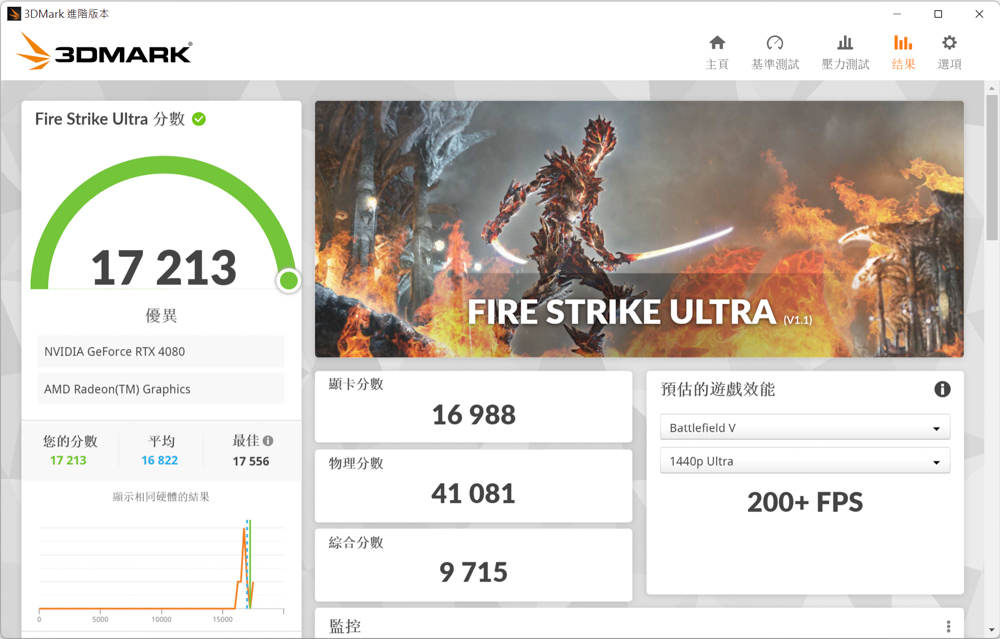
3DMark Time Spy is a benchmark test that utilizes the DirectX 12 GPU API and is specifically designed for gaming performance evaluation. It offers a resolution of 2K (1440p) and also includes a 4K (2160p) Time Spy Extreme project for more demanding game performance testing. In the test, the Time Spy project achieved a total score/graphics card score of 24773/28188, while the Time Spy Extreme project yielded a total score/graphics score of 13168/14120.
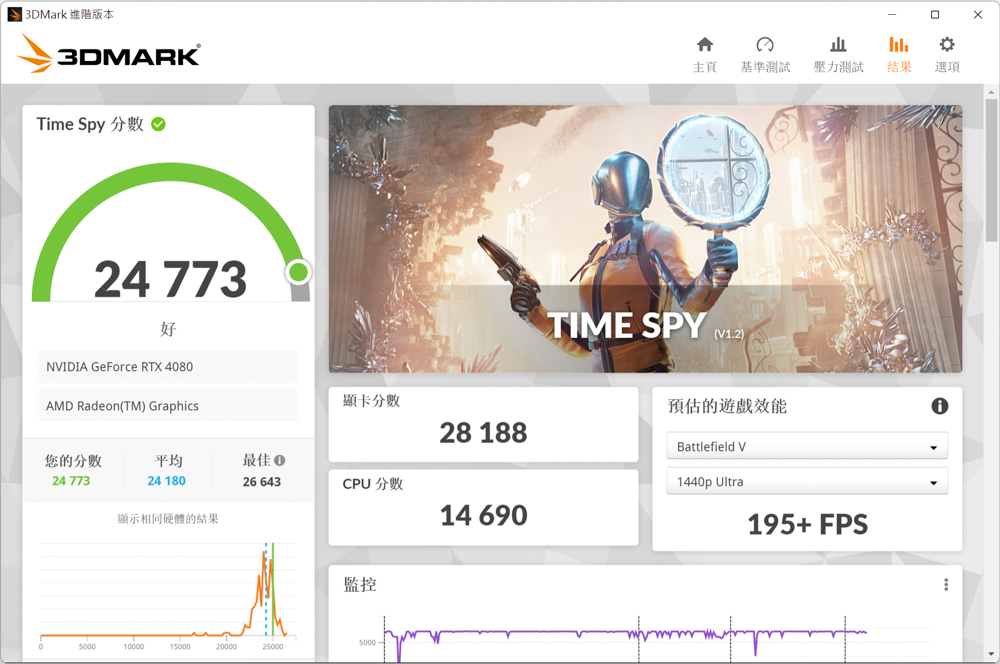
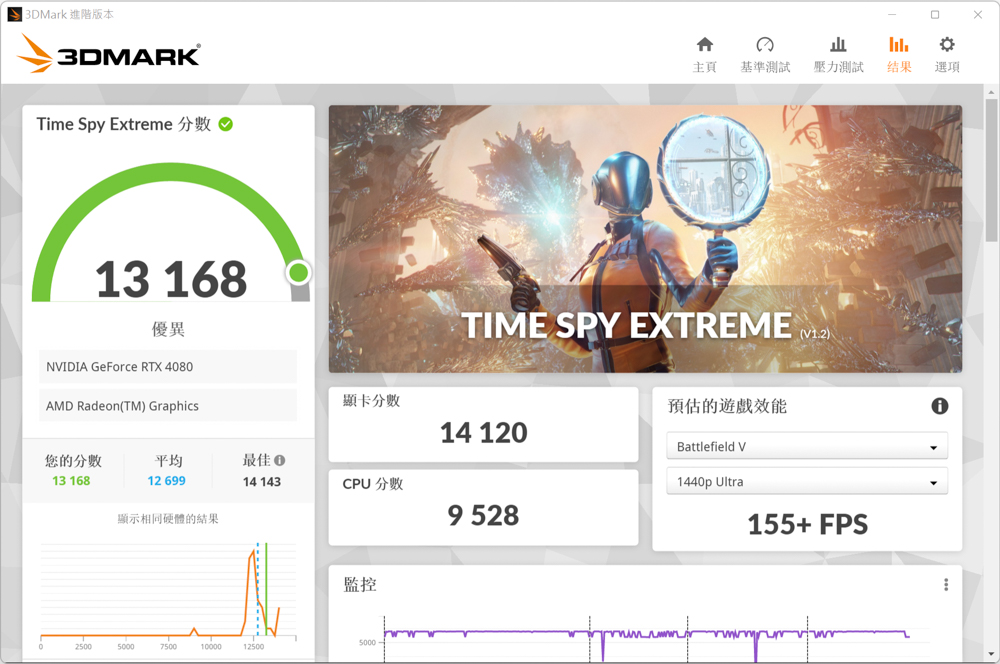
The Port Royal test project in 3DMark is built on the DirectX 12 DXR API and incorporates real-time ray tracing and DLSS (Deep Learning Super Sampling) in its 2K quality test. It is considered the first benchmark test specifically designed to evaluate real-time ray tracing performance for gamers. The summary score achieved in the Port Royal test was 17938 points.
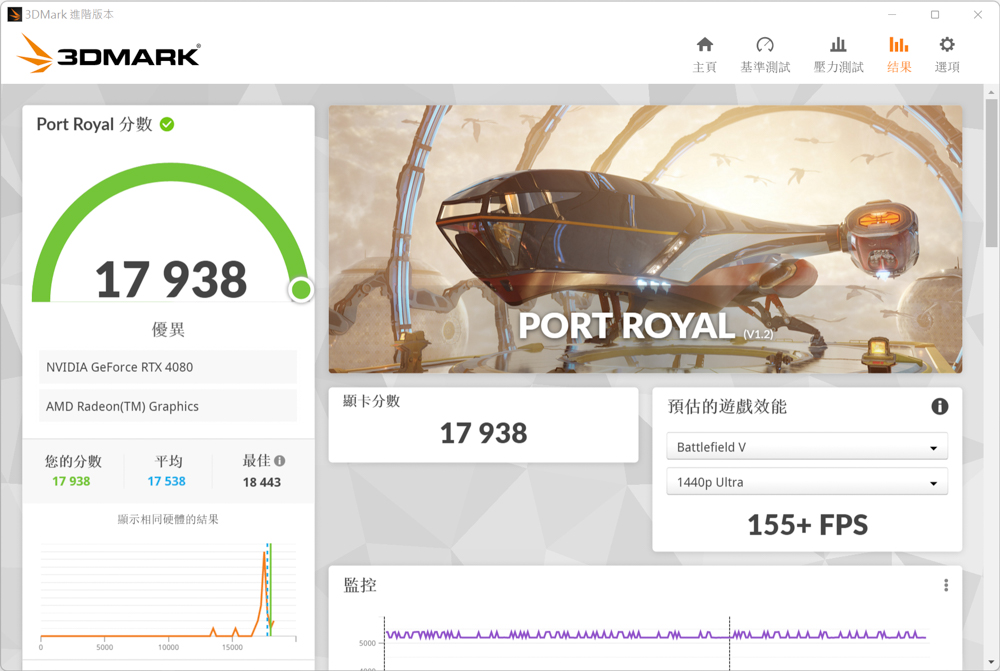
Speed Way is a benchmark test developed using the latest DirectX 12 Ultimate API. It incorporates DirectX Raytracing tier 1.1 to provide real-time ray tracing effects, including global lighting, ray tracing reflections, and Mesh Shader, among other cutting-edge technologies. Speed Way serves as the latest benchmark test for assessing ray tracing game performance, offering players a reference point. It achieved a score of 7211 in the Speed Way benchmark.
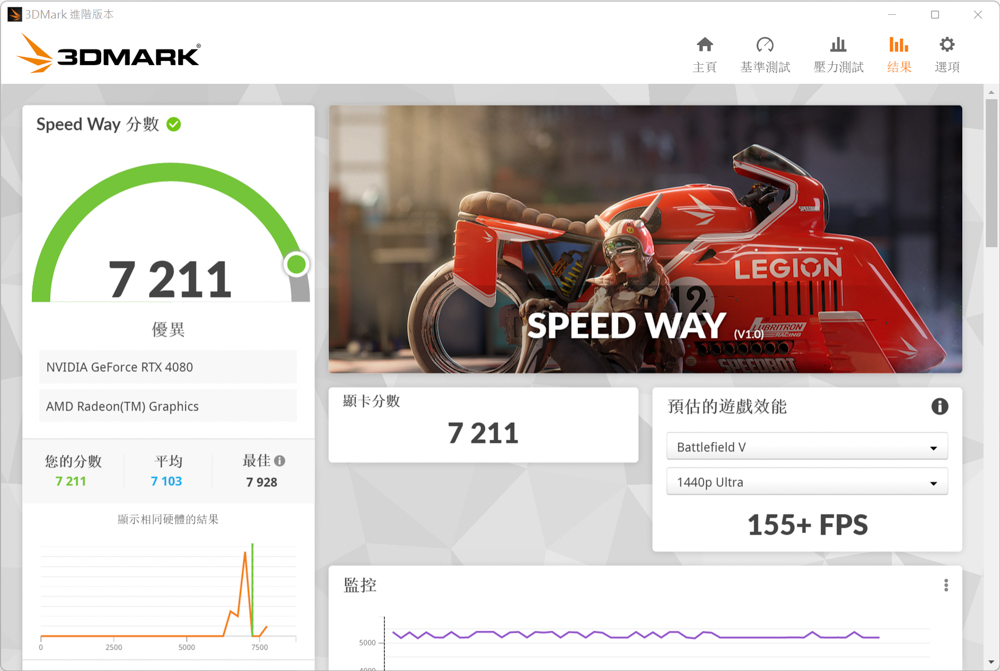
The 3DMark DLSS function test allows users to quickly assess the frame rate improvement brought about by the NVIDIA DLSS (Deep Learning Super Sampling) feature by enabling or disabling the DLSS setting. Users can choose to run the NVIDIA DLSS function test using DLSS 3, DLSS 2, or DLSS 1. However, only the latest NVIDIA RTX 40 series graphics cards support the DLSS 3 project. The test provides four resolution options: 1080p, 1440p, 4K, and 8K (DLSS 2/DLSS 3 only) for comparisons.
This benchmark test follows the same process as the Port Royal test and is run twice to obtain results. For the image qualities of 1080p, 1440p, and 4K, users can choose between the Quality and Performance modes for DLSS. The 8K resolution also offers an Ultra Performance mode. The test utilizes the Performance mode for image quality and the Ultra Performance mode for 8K image quality. The benchmark results include frame rate (FPS) charts depicting the impact of enabling and disabling DLSS across different image qualities for the three DLSS versions supported by the graphics card.
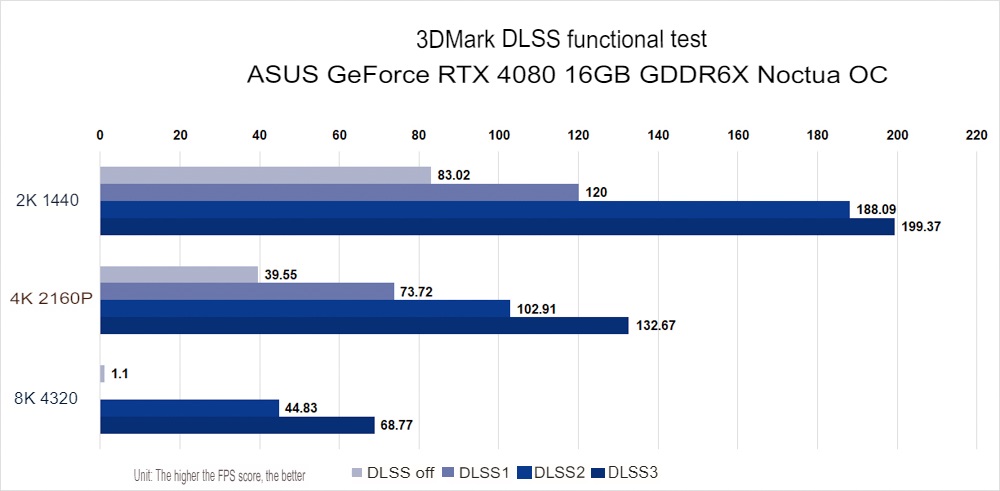
Three FPS-type e-sports games test
In the actual testing of three iconic FPS games, namely “Overwatch 2,” “Rainbow Six: Siege,” and “Apex Legends,” the ASUS GeForce RTX 4080 16GB GDDR6X Noctua OC graphics card is capable of meeting the requirements for 4K 144Hz gameplay. However, it’s worth noting that Apex Legends has a default frame rate limit of 144 frames. If users wish to achieve a higher frame rate limit, they would need to manually modify the program code. Therefore, the author will test the collected frame rates in Apex Legends based on the preset limitations.
Nine AAA Masterpiece game tests
For the AAA game test focused on-screen performance and storyline experience, the author has chosen nine 3A masterpieces: “Hogwarts Legacy,” “The Witcher 3: Wild Hunt,” “Cyberpunk 2077,” “Watch Dogs: Legion,” “Far Cry 6,” “God of War,” “Red Dead Redemption 2,” “Horizon Zero Dawn,” and “Assassin’s Creed Valhalla.”
Considering that most players prioritize visually stunning graphics over the highest frame rates when playing these 3A games, the author has set the texture and special effects options to the “highest” setting within the games. Additionally, in most of these games that support NVIDIA DLSS technology, the author has selected the “Quality” or “Image Quality” mode for DLSS to achieve a certain degree of frame rate improvement while maintaining excellent visual performance. The frame rate measurements include the average (AVG), and 1% Low FPS recorded using the software.
Five ray tracing games tested
The NVIDIA RTX 40 series graphics cards, equipped with the third-generation RT Core, offer improved ray tracing performance compared to the previous RTX 30 series. For testing purposes, five DXR (DirectX Raytracing) games were selected: “Hogwarts Legacy,” “The Witcher 3: Wild Hunt,” “Cyberpunk 2077,” “Watch Dogs: Legion,” and “Far Cry 6.” In these games, the screen special effects and ray tracing settings were set to the “Highest” level, while DLSS 3 was enabled in the quality image mode, and AMD FSR (FidelityFX Super Resolution) was set to the highest quality mode.
In addition to the five ray tracing games mentioned above, the author also included the “Enemies” demo test file provided by NVIDIA. “Enemies” is a new-generation technology showcase developed using the Unity 3D game engine. The beta version of “Enemies” supports real-time ray tracing and NVIDIA DLSS 3, and operates at a 4K resolution. By toggling DLSS 3 on and off in the 2160p test project, players can observe the difference in frame rates rendered by the Unity engine with DLSS 3 enabled at 4K quality.
Display card temperature and power consumption test
The graphics card is tested on an open test platform in an indoor environment with a temperature of 25°C to measure the temperature and power consumption. The author conducted actual measurements using “Cyberpunk 2077,” Time Spy, and Furmark. HWiFO64 was used for data collection, recording the highest GPU temperature (GPU temperature), graphics memory junction temperature (GPU Memory Junction Temperature), and GPU power consumption. Please note that software-based monitoring of GPU power consumption may have a deviation of 1-3%, and the data collected should be considered as a reference only.
Summarize
The ASUS GeForce RTX 4080 16GB GDDR6X Noctua OC overclocking special graphics card, developed in collaboration between ASUS and Noctua, doesn’t differ much in terms of appearance design from their previous cooperative products like the RTX 3080/3070 Noctua OC. The main differences lie in the color scheme, with some tweaks made.
Noctua fans have always been known for their dullness, quietness, low temperature, and signature coffee color, which has garnered them a dedicated following. The inclusion of two NF-A12x25 PWM fans in the cooling module truly reflects the original Noctua brand belief. However, it may not be necessary to match the NVIDIA Ada Lovelace architecture RTX 4080 core. The original version of the RTX 4080 with its power consumption of around 300W already performs admirably and maintains excellent temperature control. The inclusion of two 12cm fans and an upgraded cooling module may not be a necessity.
In terms of game performance, the ASUS RTX 4080 Noctua OC can easily meet the requirements for 4K gaming at 100 frames per second in 3A games. It achieves an average of 100 frames in six ray tracing projects. During gameplay, the graphics card’s temperature rarely exceeds 65°C. However, while it provides strong cooling performance, its large cooling module can pose challenges in terms of size, potentially impacting the compatibility with the chassis and motherboard expansion slots during installation.
The ASUS GeForce RTX 4080 16GB GDDR6X Noctua OC Overclocking Special Edition is currently available in Taiwan through various sales channels at a price of NT$49,990, which is similar to the ROG STRIX series. If you have a fondness for Noctua brand products and wish to assemble an owl-themed PC, the new RTX 4080 Owl Special Edition is definitely worth considering!
If this article is helpful for you, please share this article with your friends on social media. Thank you!
This article is based on the personality of the reviews. You are responsible for fact-checking if the contents are not facts or accurate.
Title: Unboxing and Testing the ASUS GeForce RTX 4080 16GB GDDR6X Noctua OC Graphics Card with Owl’s Eye